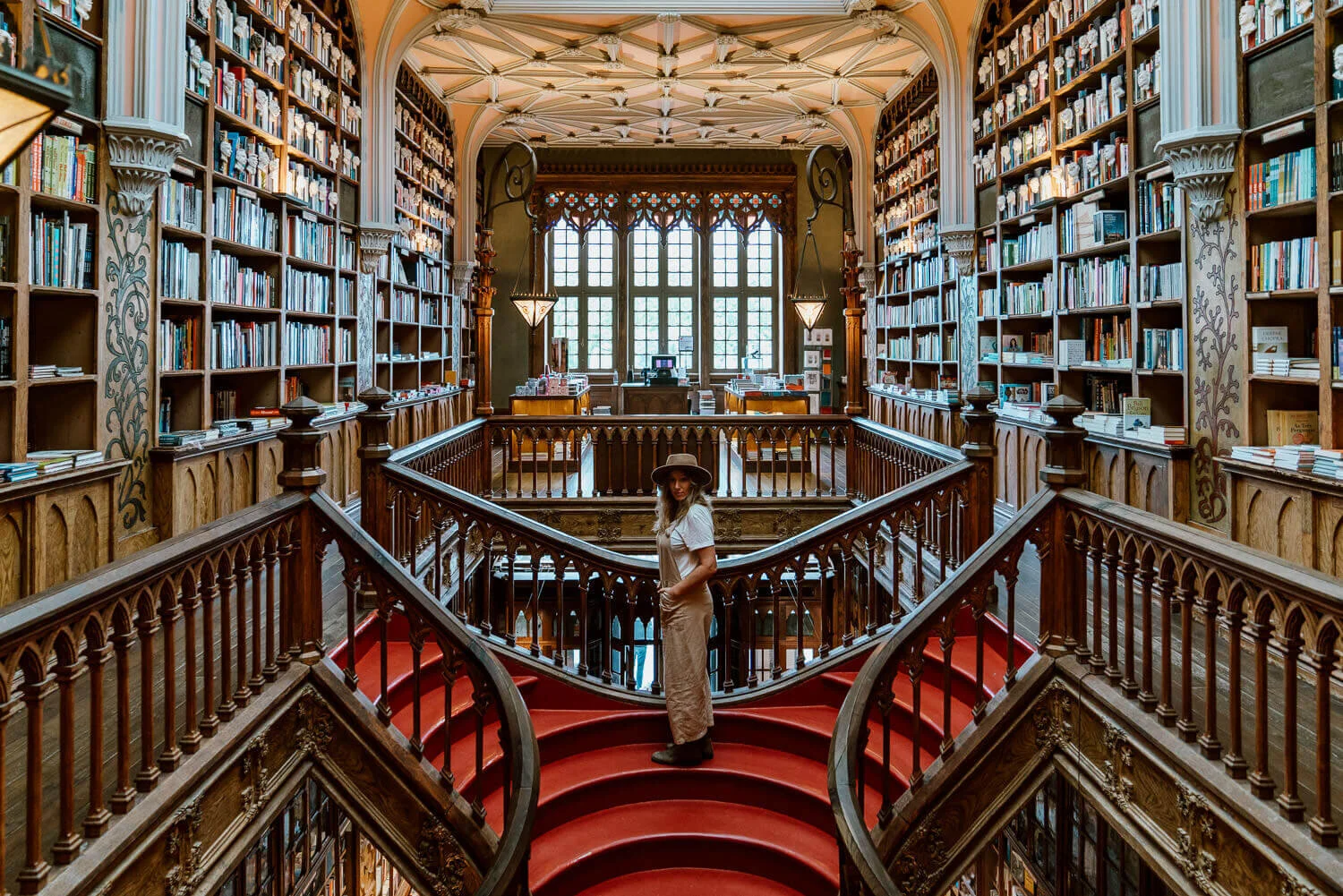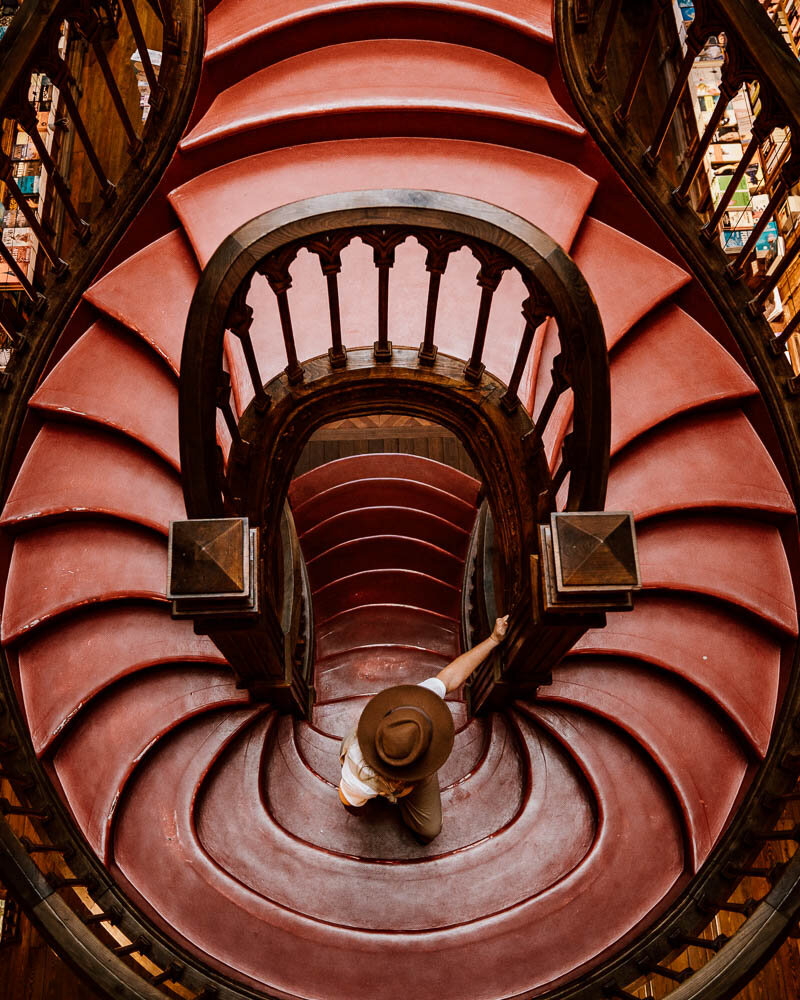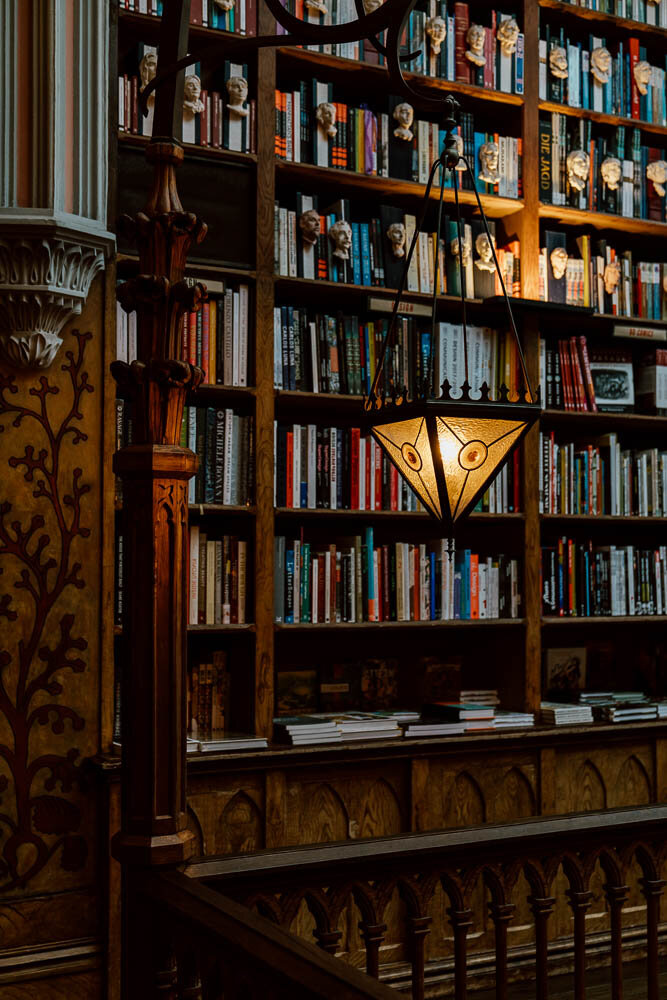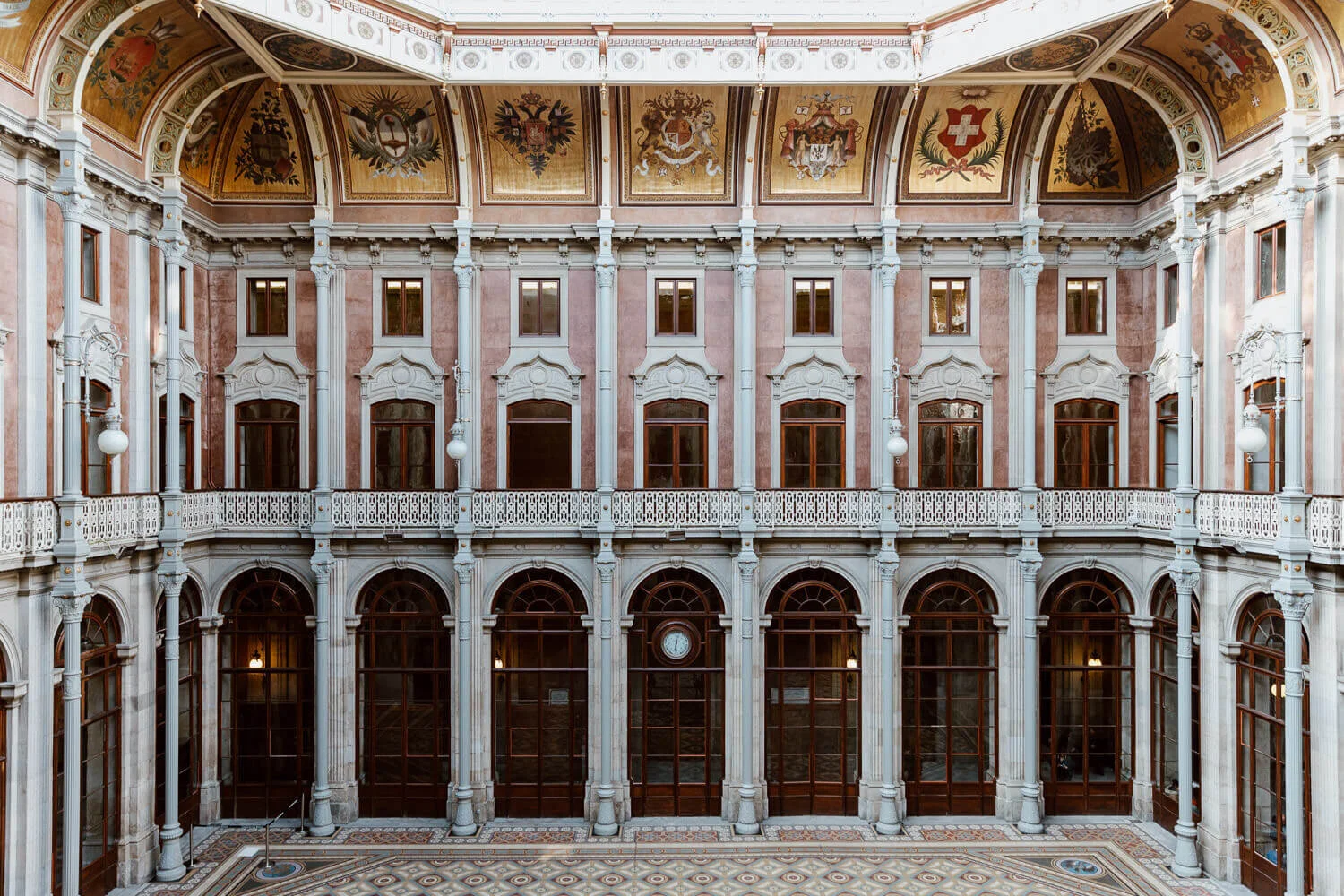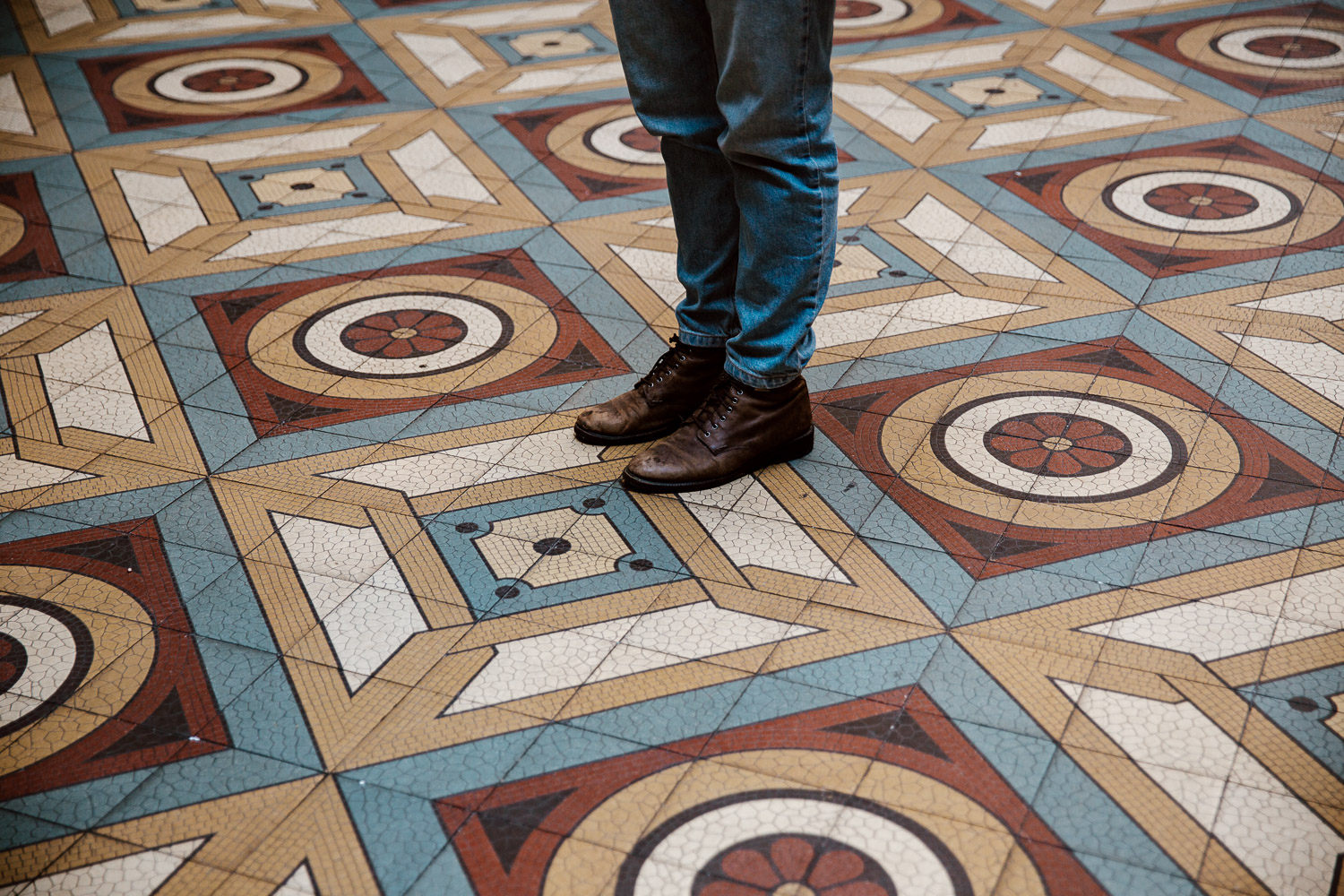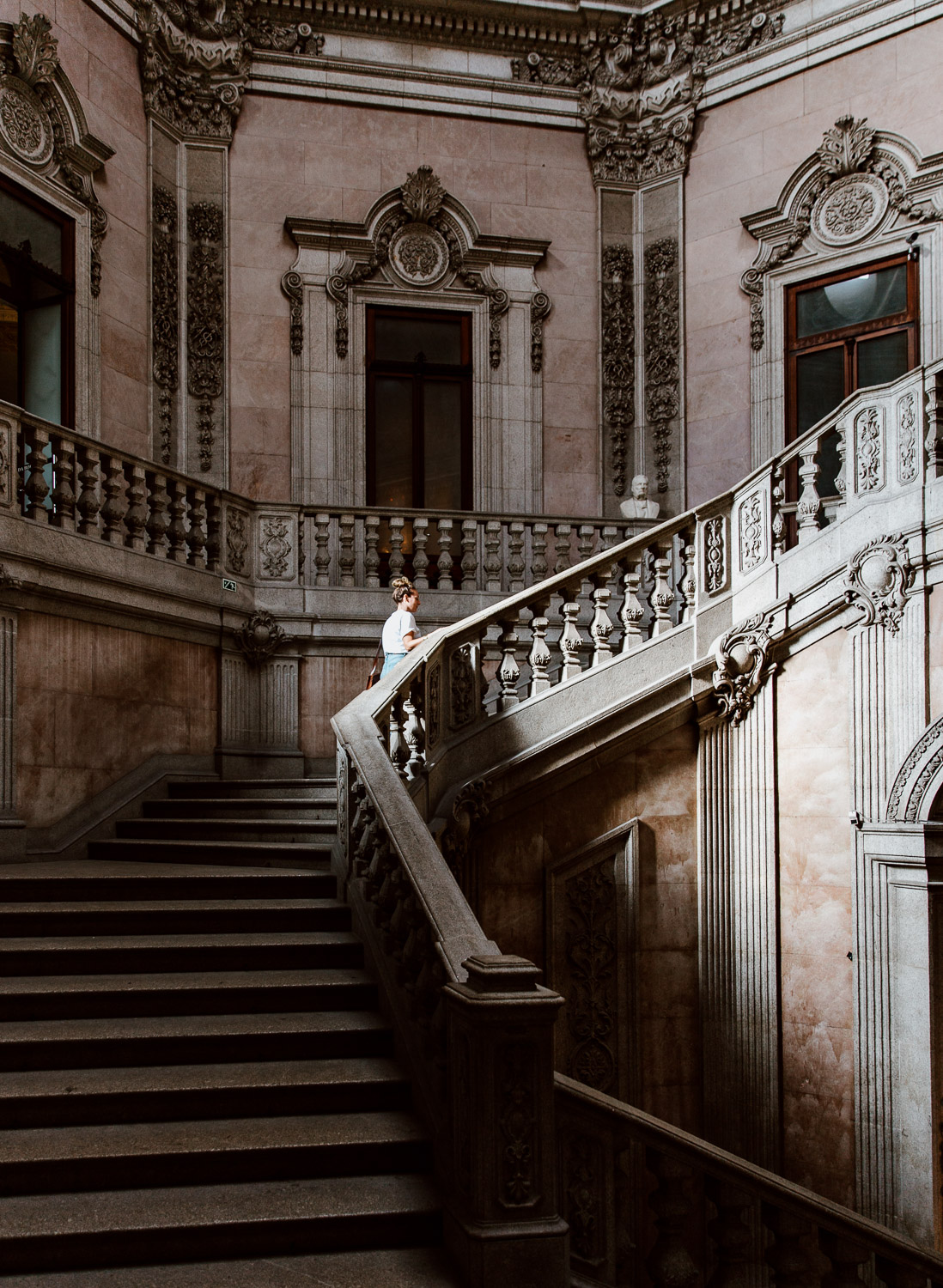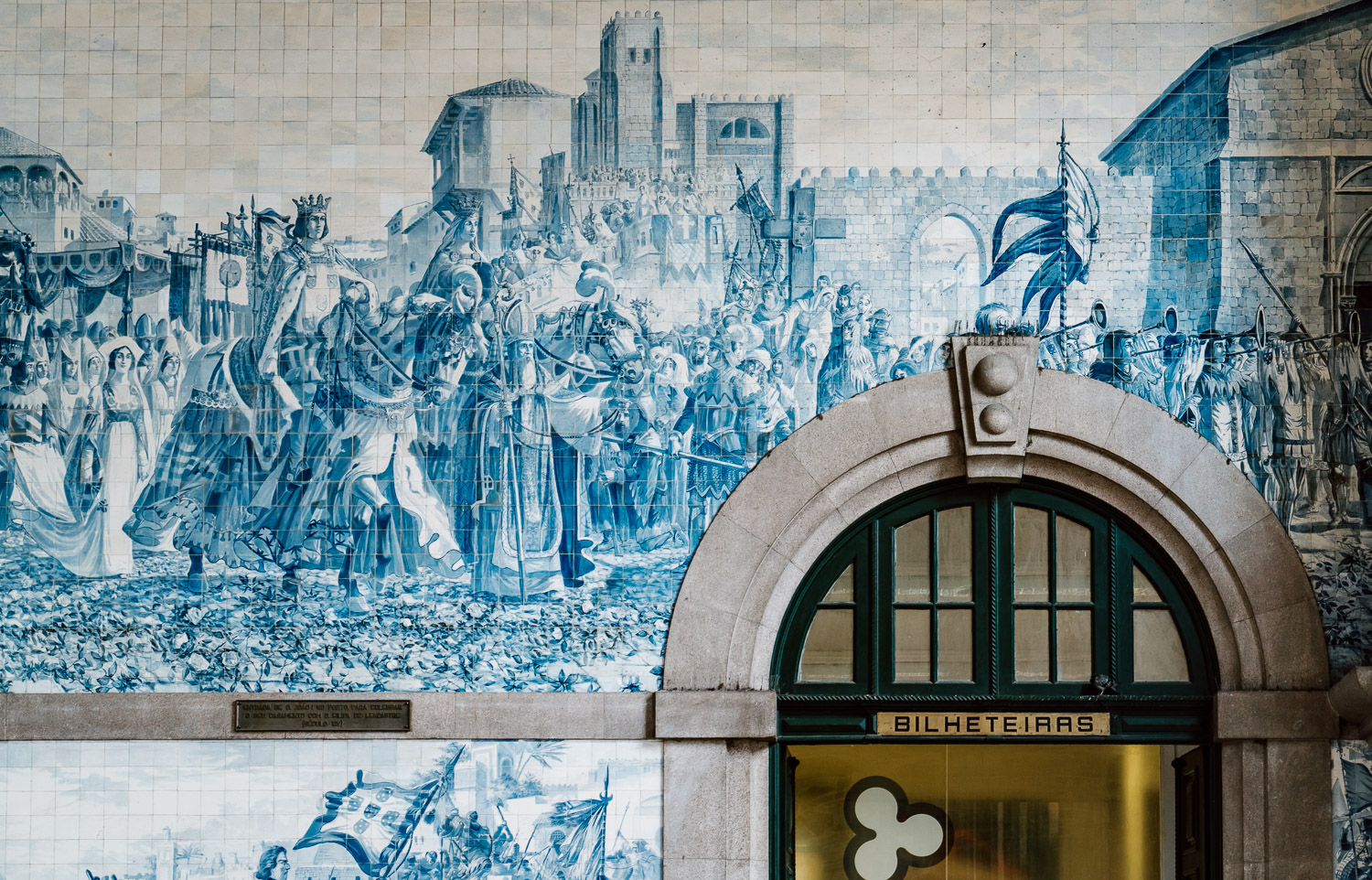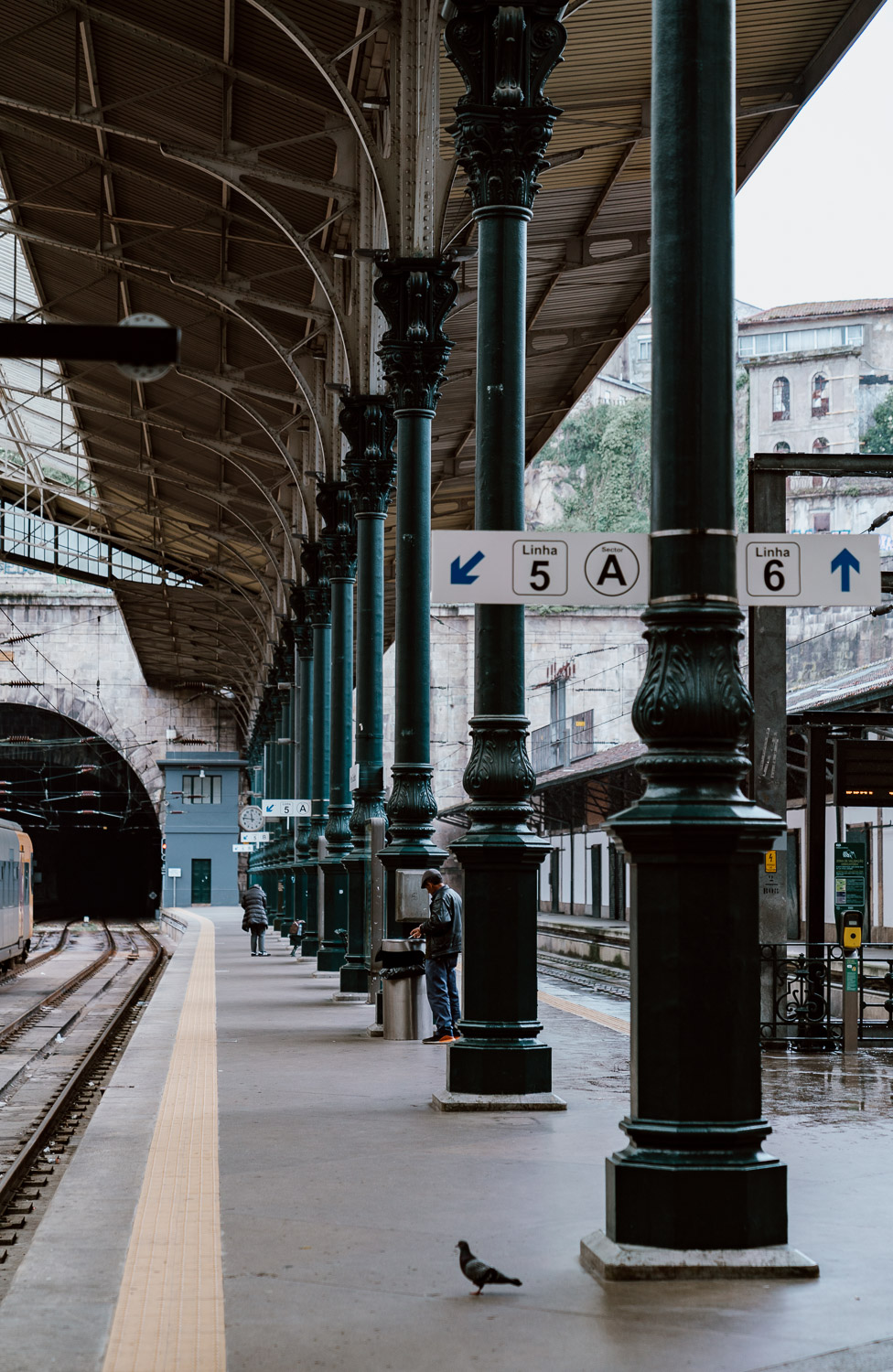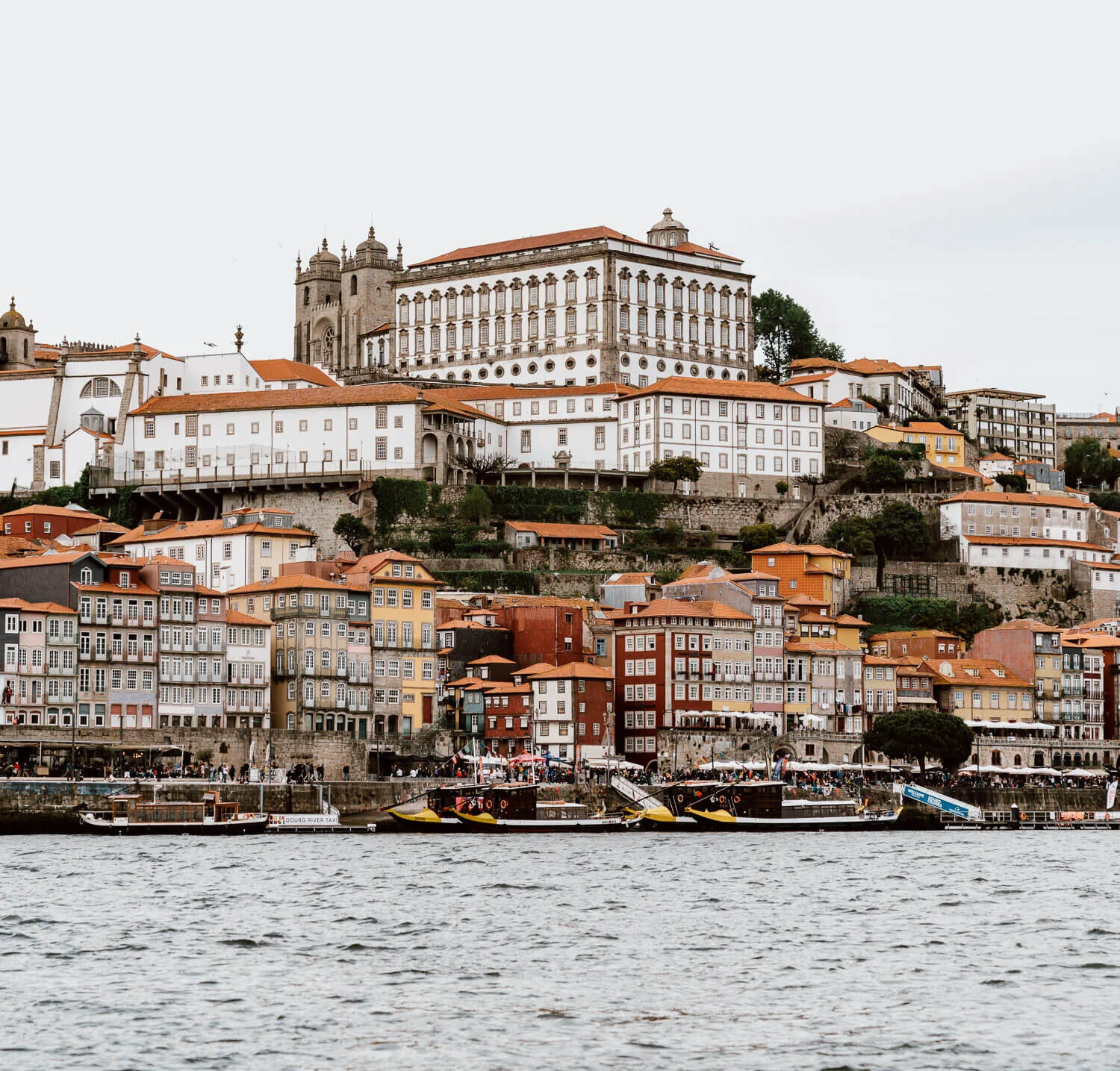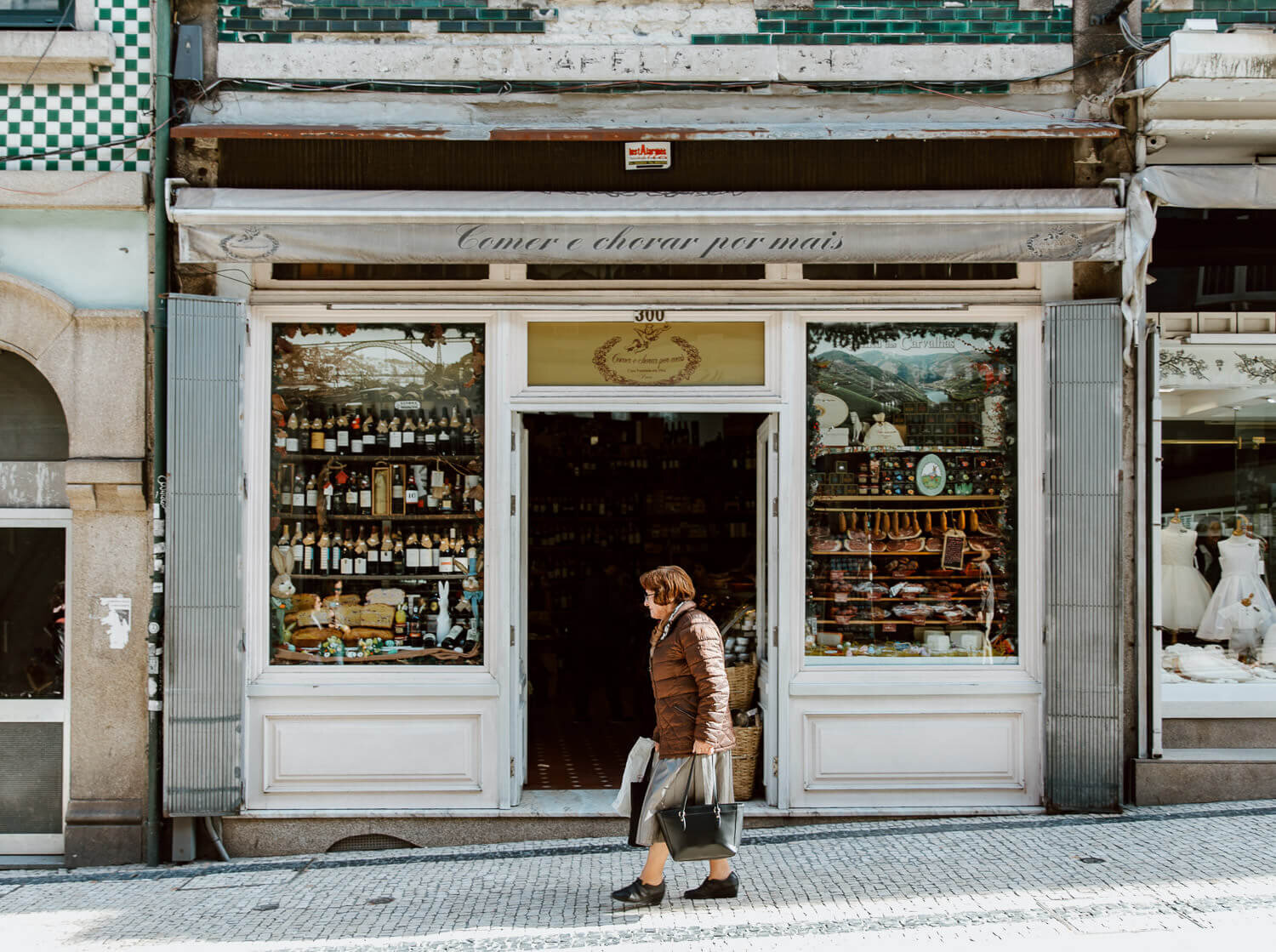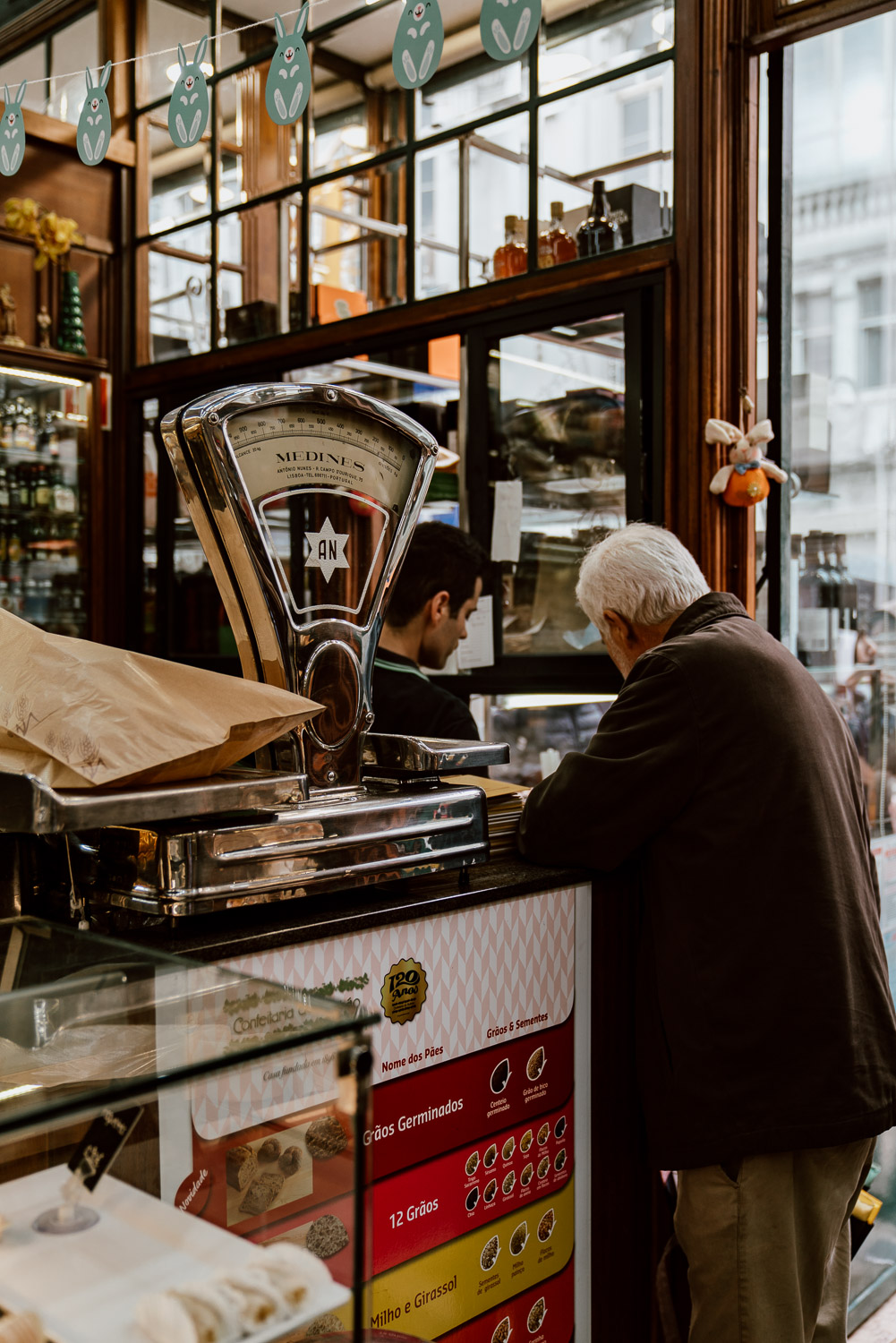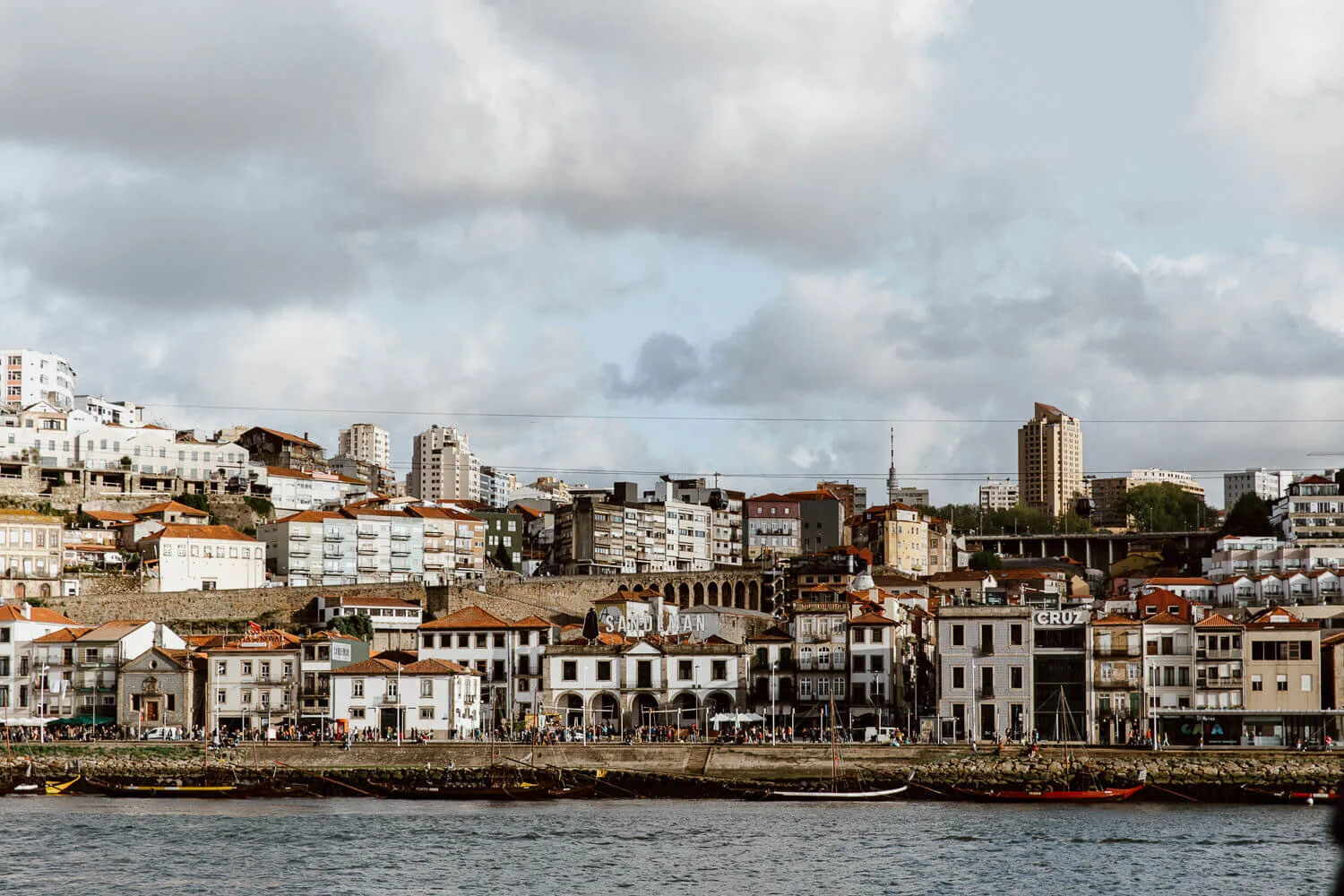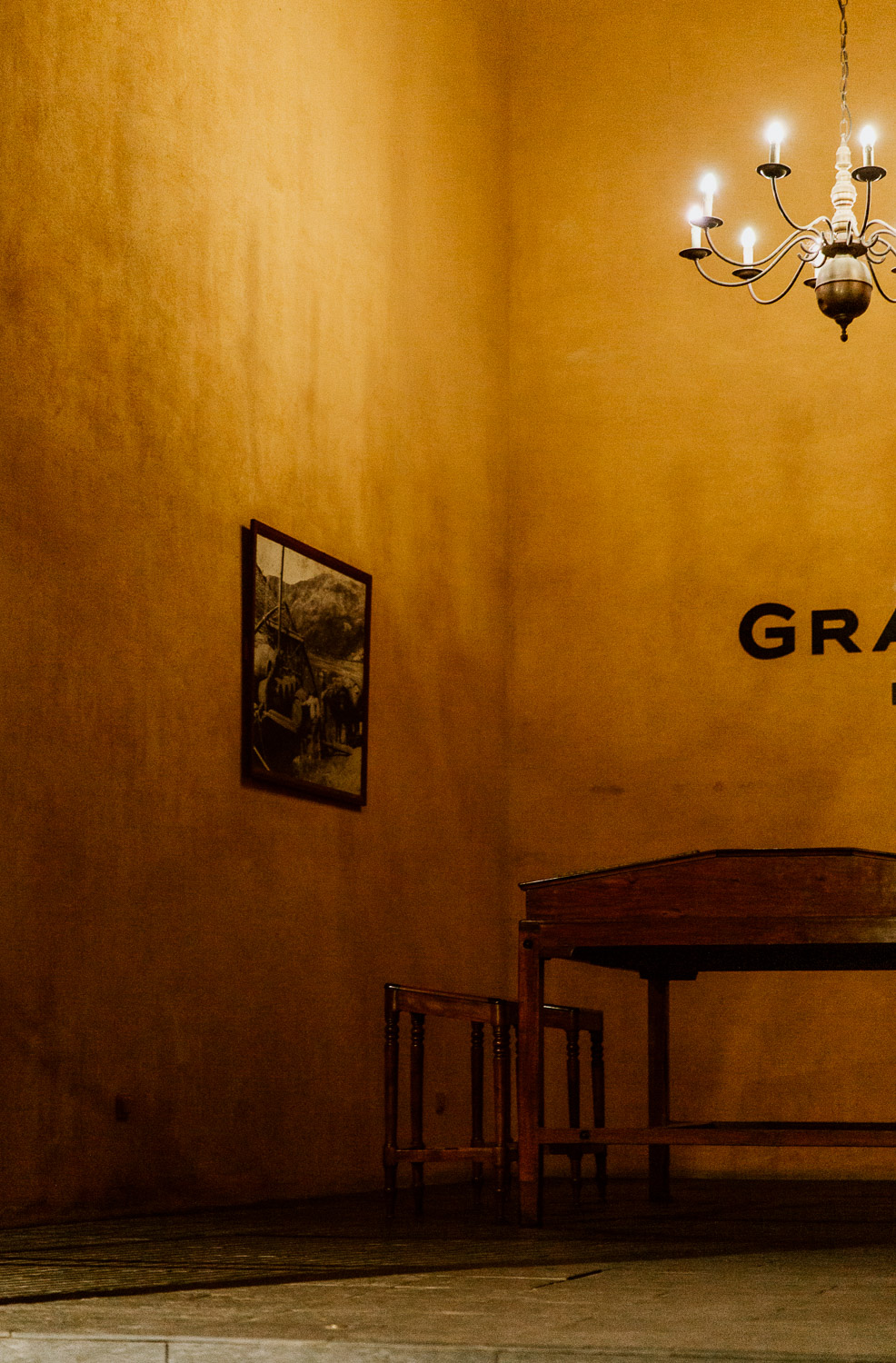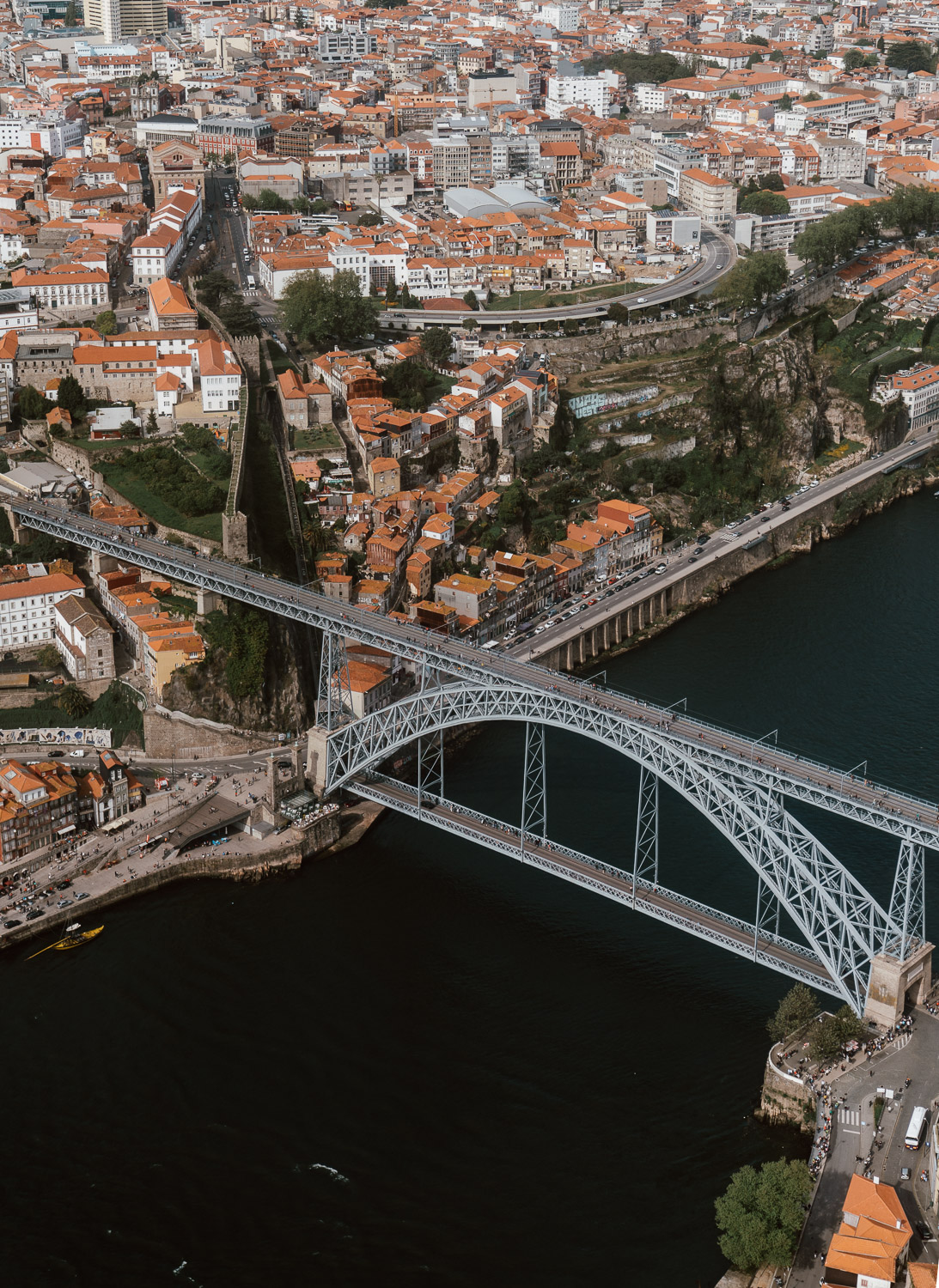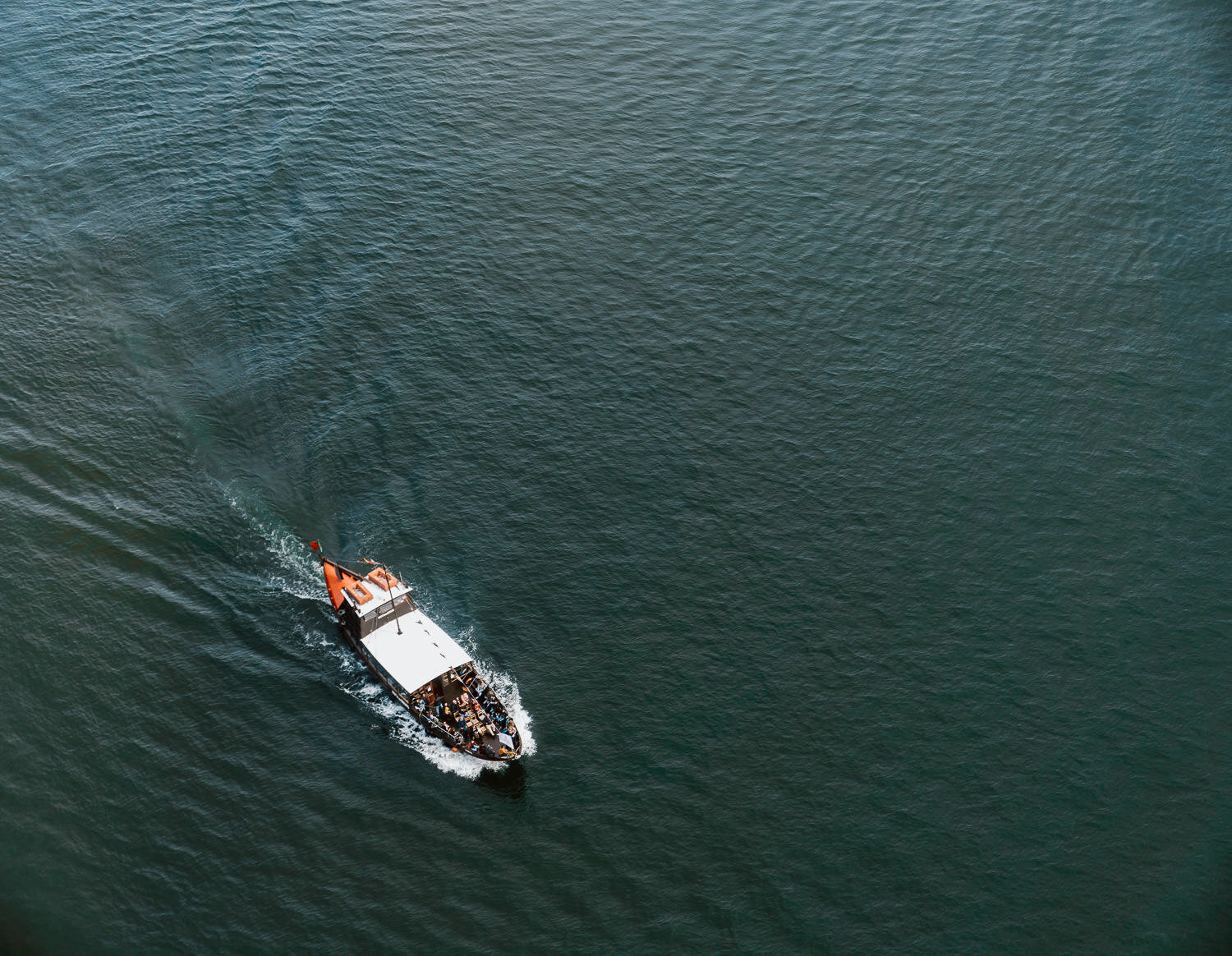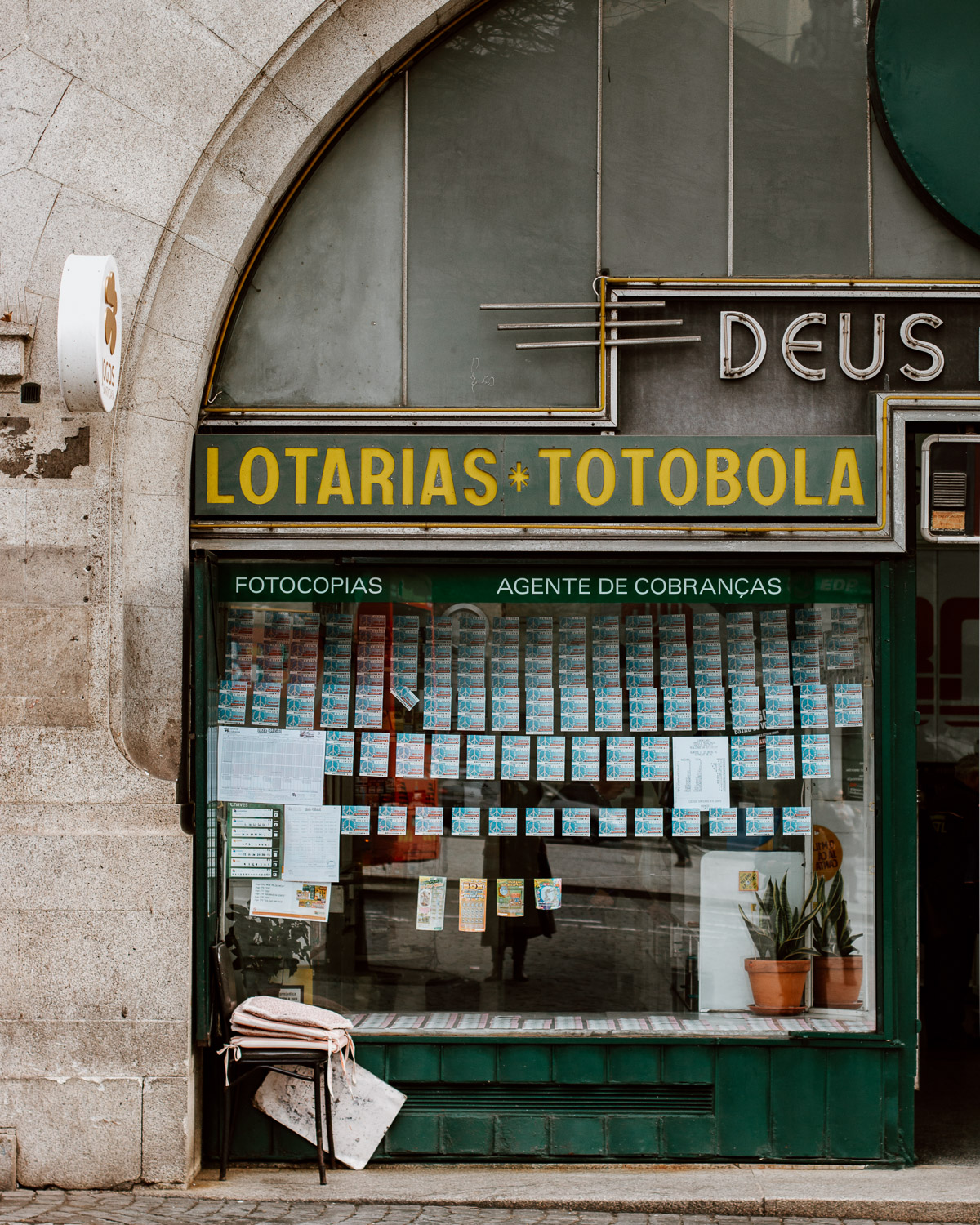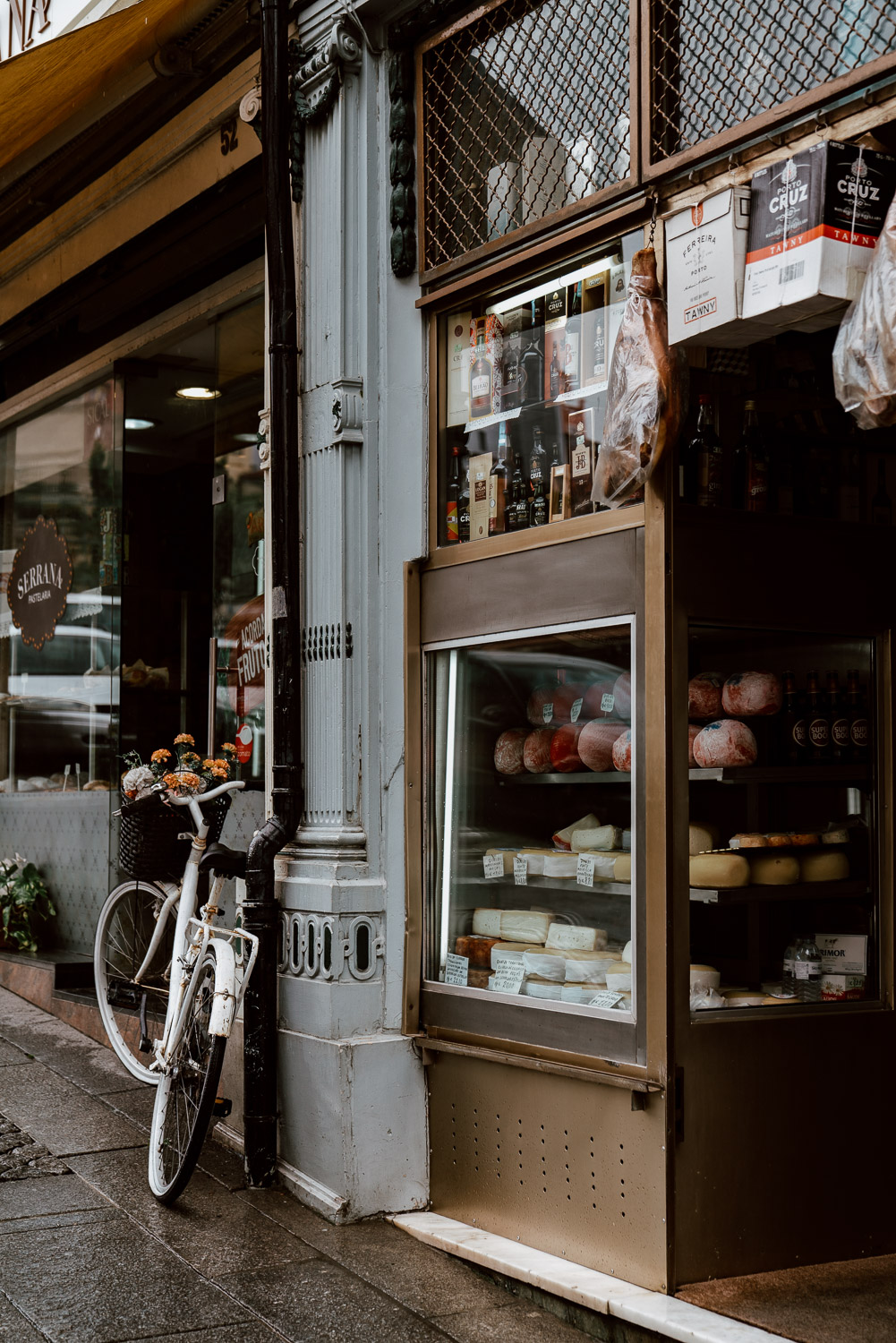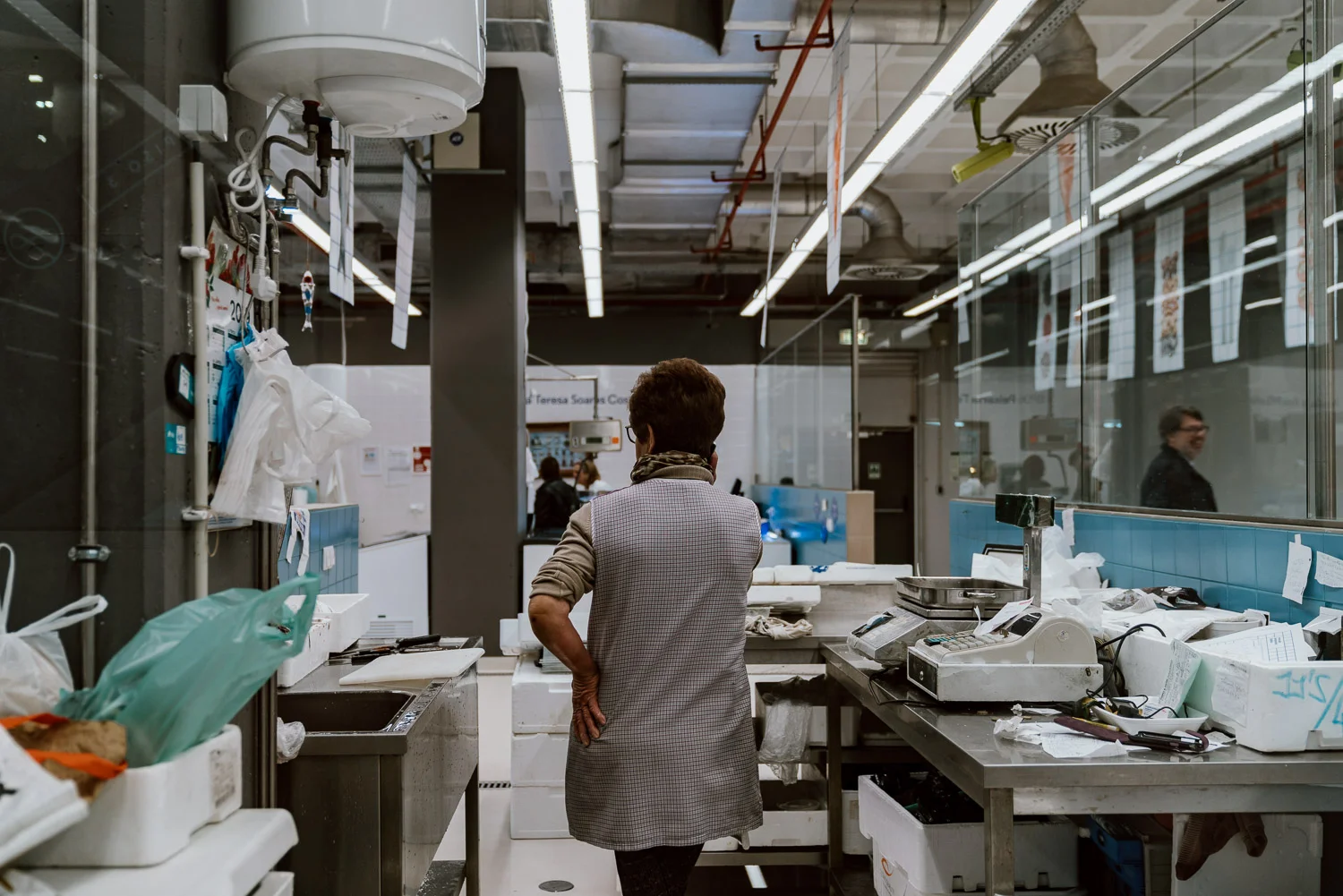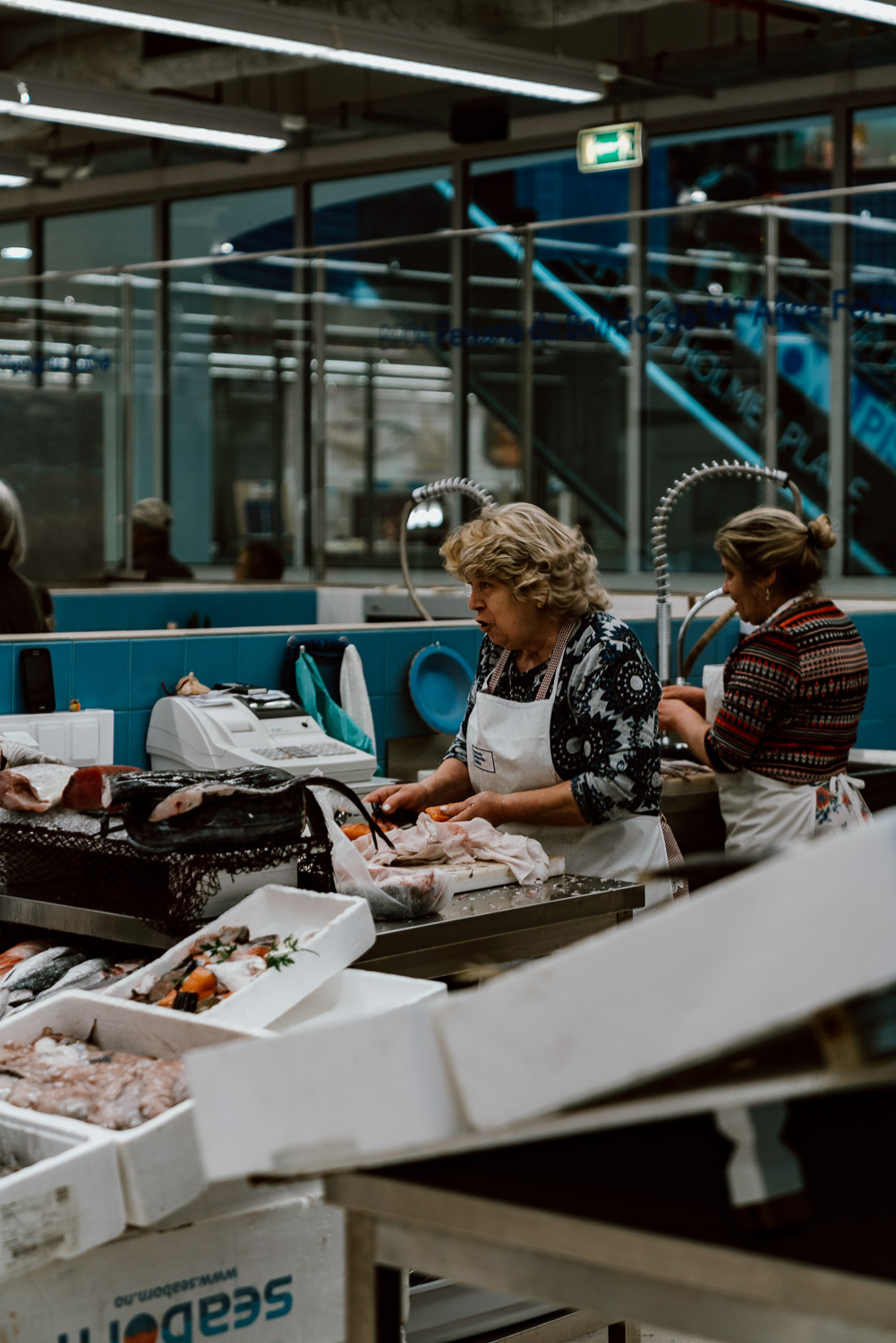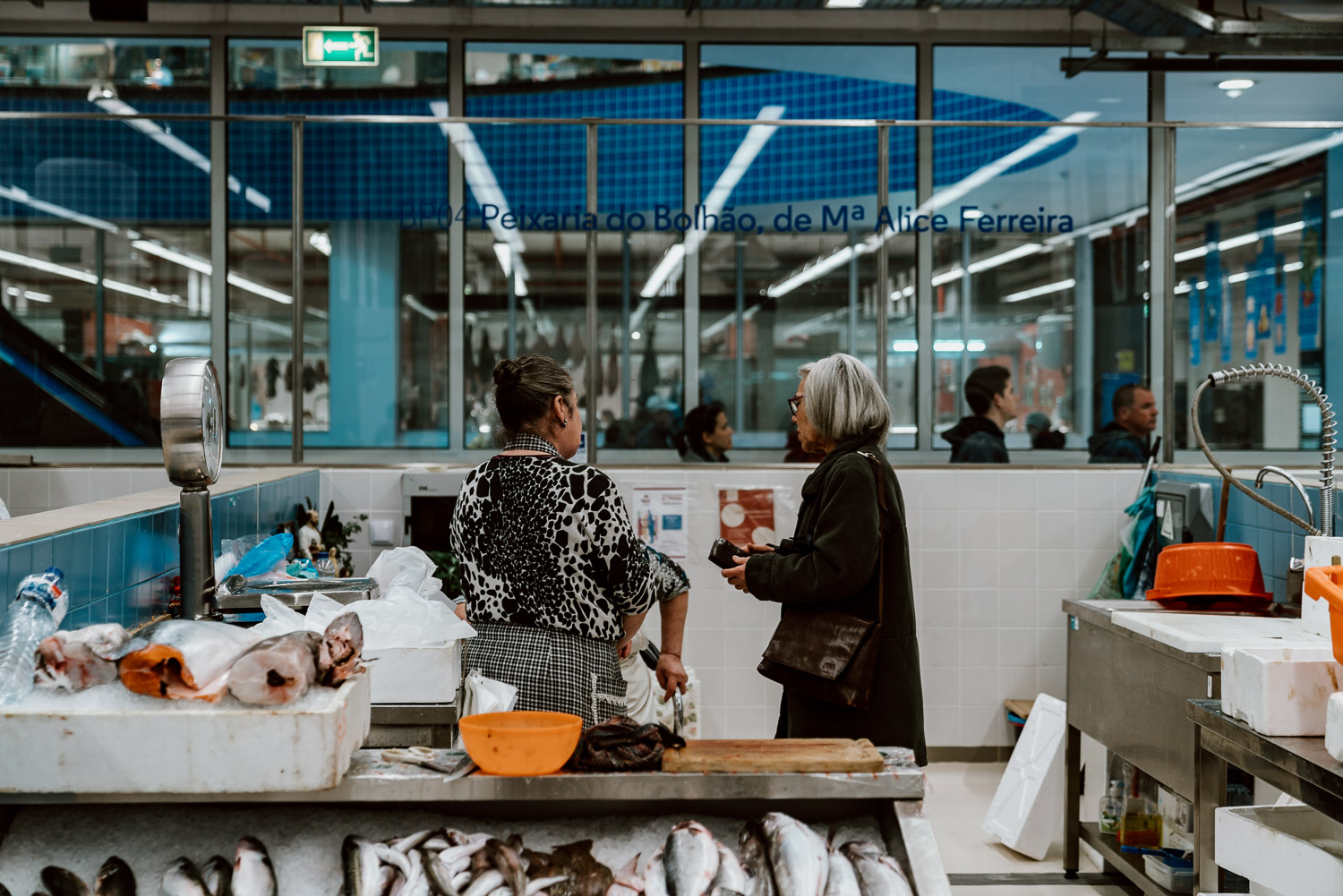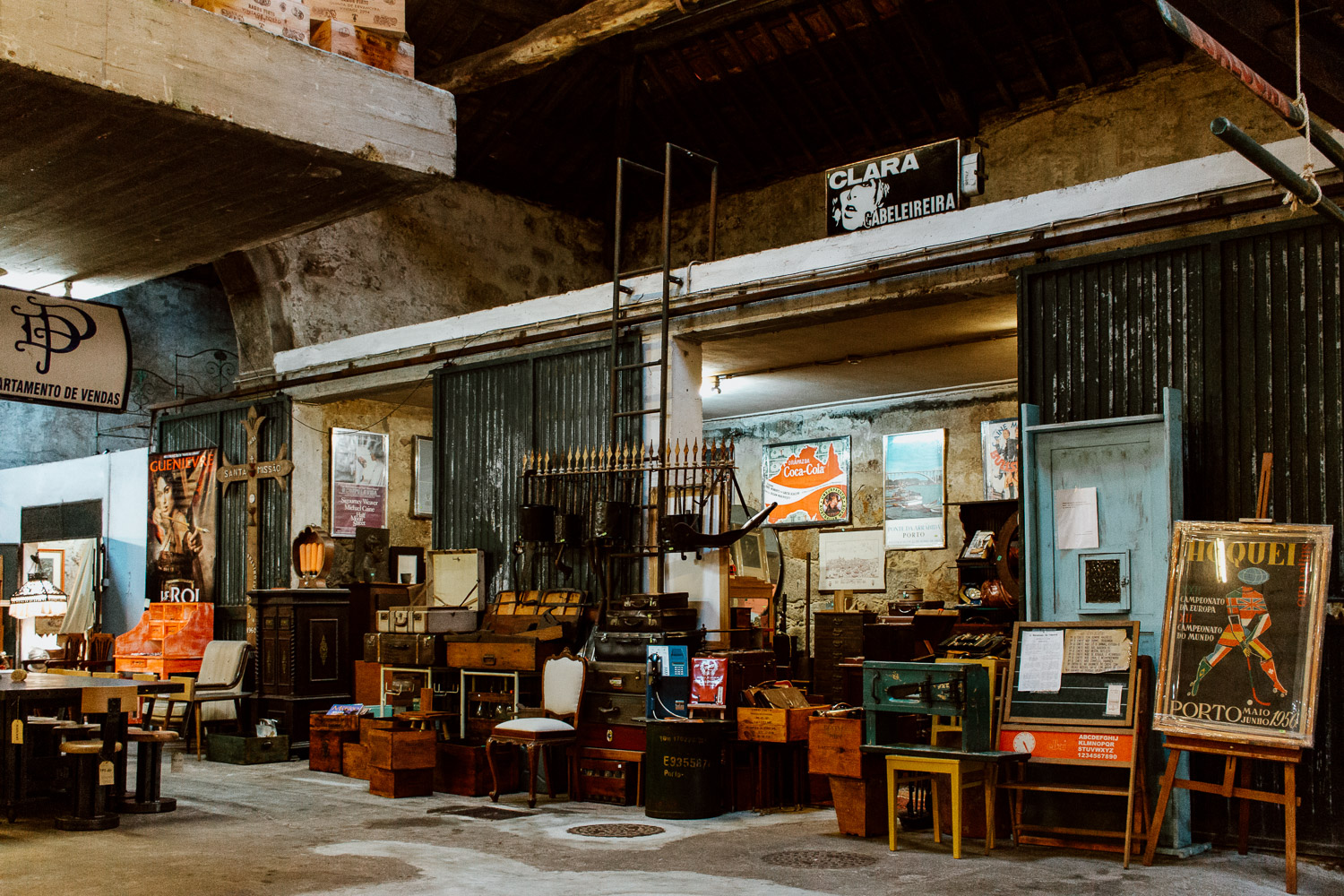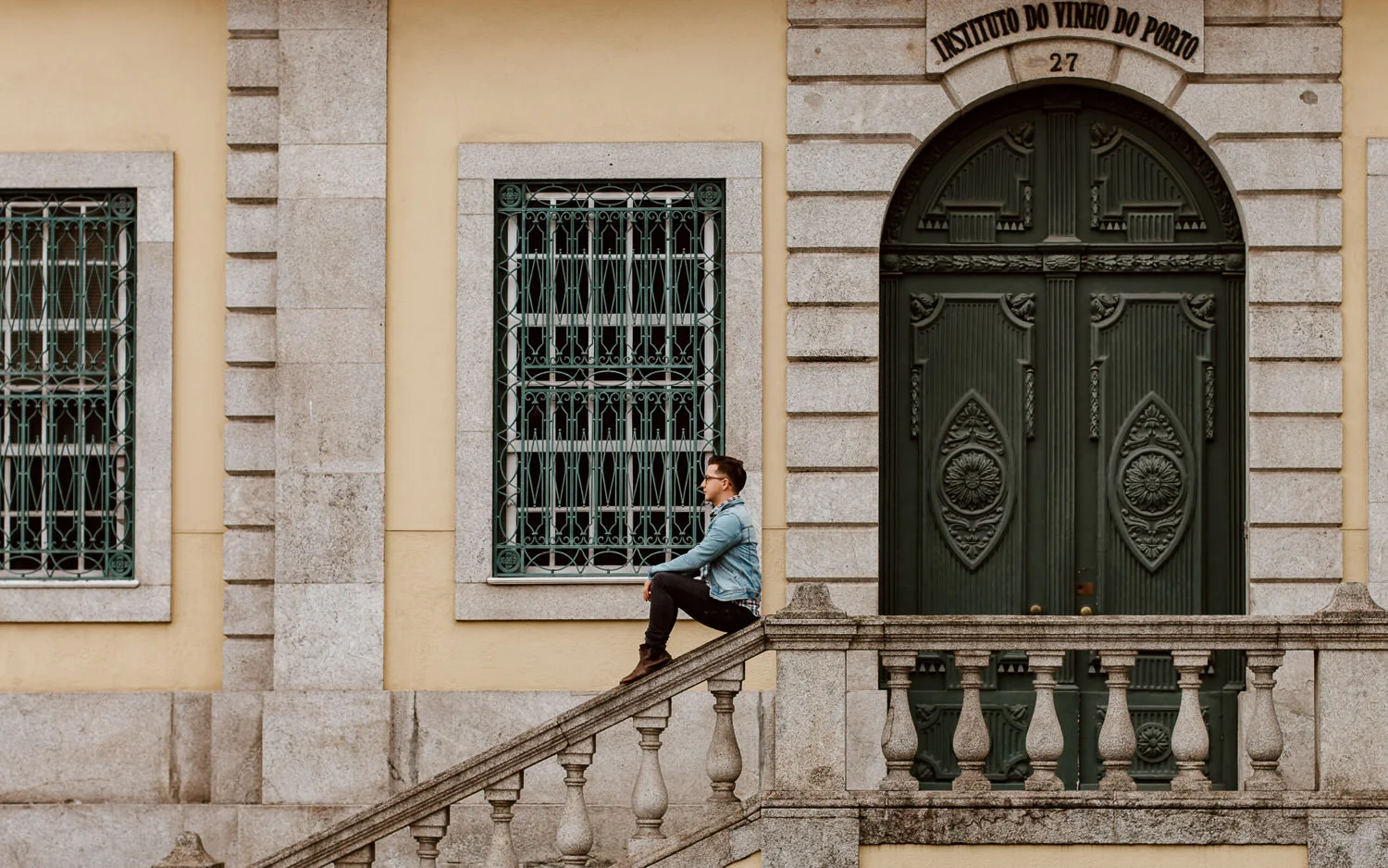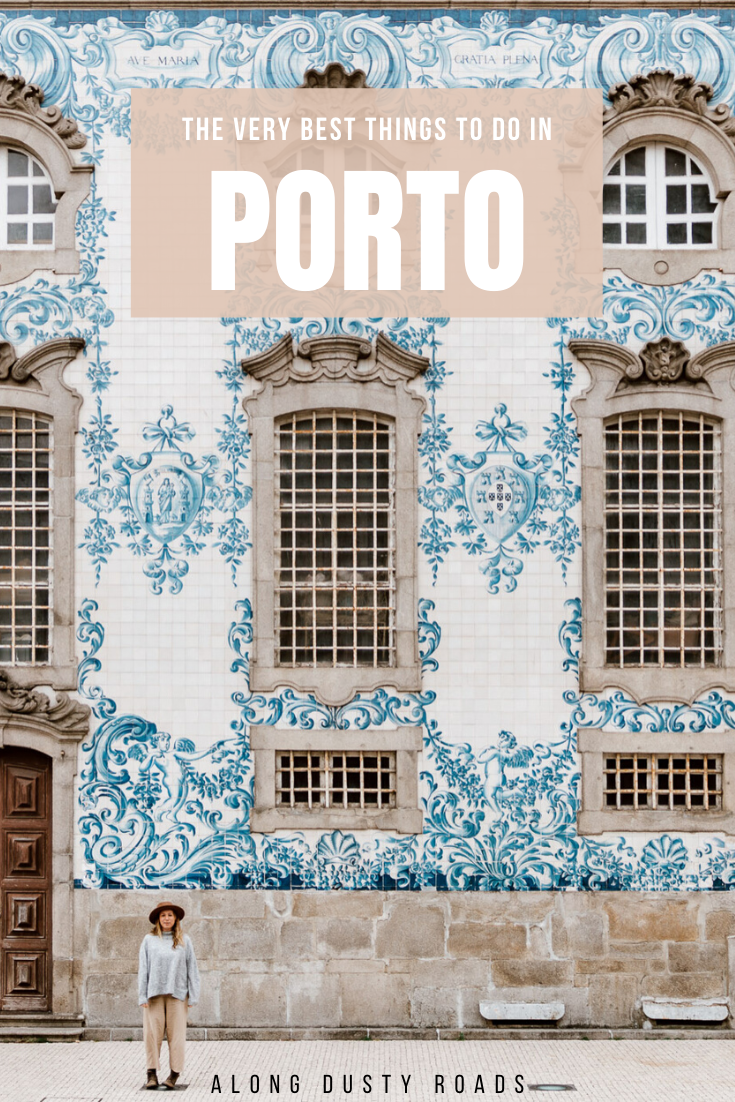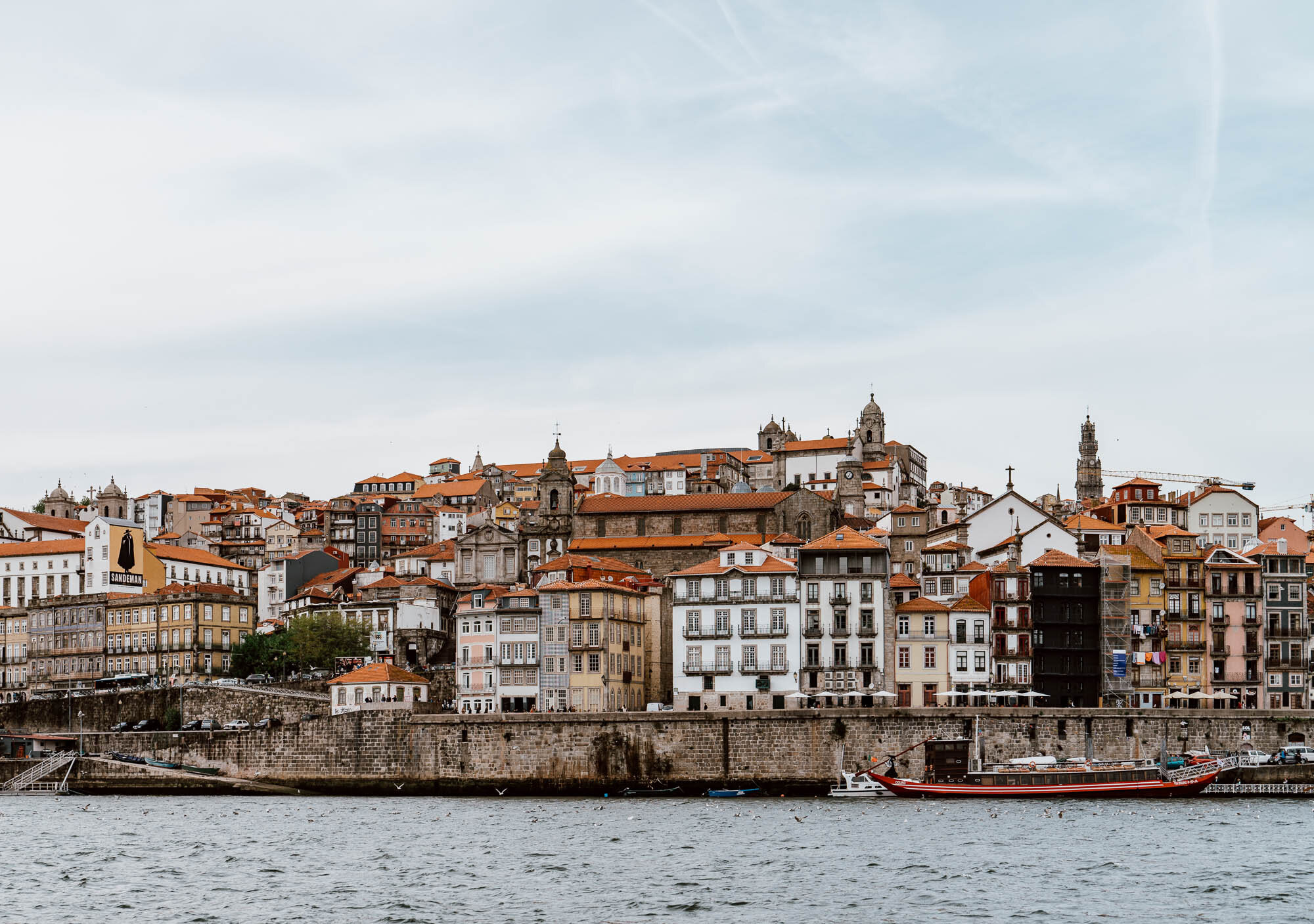Having now visited Porto twice, we’ve had the opportunity to sample much of what this historic city has to offer. So, here are our absolute favourites and our pick of the best things to do in Porto.
It’s the pops of colour which first come to mind when we think of Porto.
The blues of the azulejos depicting battles and heavenly ascensions on old church fronts. The orange rooftops as we looked out from a claustrophobic 18th century century tower. The reds and greens of the classic riverside facades in Ribeira. The rich scarlet of Lello’s helix staircase and the pinks of the Pandora’s box, Palacio Bolsa. The sunshine yellows of custard tarts fresh out the oven and pastel tones of old shop signs with typography settings we could only dream of.
Perhaps the colours remain so vivid for us as about three-quarters of the time we’ve spent in Portugal’s second city has been accompanied by a stubborn grey sky casting its pallor across the granite and marble buildings on the ruas and avenidas which snake upwards from the steep banks of the river Douro. We have the unfortunate habit of bringing that sort of weather with us to places which we have sought out purely in search of sunshine, and distraction from the doldrums of a long, dark British winter.
Nevertheless, across those two city breaks in winter and spring, we have covered much of what Porto has to offer to the first-timer, as well as explored a little further afield in search of different experiences and perspectives. In that four year span between visits, it was clear to us that Porto’s popularity has spiked dramatically amongst all sorts of travellers - but if you go at your own pace and with a curious mind, you can still find a lot to love.
Even if the sun doesn’t shine every day.
Here are our personal recommendations on 13 wonderful things to do in Porto.
13 Wonderful Things to do in Porto
Line up for Livraria Lello
Firmly established as one of the world’s most beautiful bookshops, Livraria Lello is today the most popular tourist attraction in the city with queues stretching down Rua das Carmelitas from the early morning hours well before its heavy doors open at 9.30 a.m.
The dream of the two brothers Lelllo, it was built in 1906 as a home for the studious, the curious, and the intellectual. Today however, the bookshop reflects the dramatic growth of Porto as a tourist destination, the impact of Instagram, and the effect of Harry Potter on this historic city’s own story.
Legend has it that JK Rowling, during her years working in the city in the early 90s, was inspired by the glorious interiors for aspects of Hogwarts. The bookshop has very much embraced this kernel, and Potter-mania is a big reason the small space and exquisite scarlet staircase attracts up to 4,000 visitors per day (more than Machu Picchu, for example). It’s hard to believe that as recently as 2015, it was free to enter and photos weren’t allowed.
Did you know | The magnificent ceiling and interiors of Lello are not made of wood, but painted plaster - a design technique which came to fashion in the early 20th century.
Although it’s easy to be sceptical of places that become so popular they’ve transformed from what they once were, stepping into Livraria Lello for the first time will still take your breath away. And, despite the jostling for photo opportunities and overcrowding, the aspect which surprised us most was that the Lello really does try to maintain itself as a bookshop first and foremost, despite its status as a tourist attraction; the €5 ticket can be redeemed against the purchase of a tome from the diverse and multilingual selection on its shelves.
Insider Tip | Whilst we’re here, we might as well mention that Majestic Cafe (Rua Santa Catarina, 112) is another place that has been transformed by Porto Potter-mania - ‘Harry Porto’ anyone? Anyone?! We didn’t know this when we passed the art-nouveau cafe (which used to be a place to visit on its own merits) with its queues of selfie-takers outside, but a quick Google let us know that JK Rowling supposedly spent some time writing her first book in the series here. Unless you’re a big fan, just give it a miss and don’t add to the crowds. One cool thing we did notice in Porto however were several Portuguese students wearing black cloaks (authentically), so perhaps that was another piece of inspiration for JK?
Need to Know | The most important thing to know, is that you cannot simply turn up at the bookshop and pay to enter. Instead, you either need to buy your ticket in advance, be that online or at the ticket shop a couple of doors down. Lello opens at 9.30 a.m. but even in off-season, people begin queueing around an hour before this, to give them the greatest chance of being in first. Do note that even if you arrive super early, you will NOT have the bookshop to yourself. The second time we we visited we were fortunate enough to have early access Lello, but the moment that it officially opened, it became very busy.
The crowds and the wait times may be enough to put you off a visit, but for many Lello will always be at the very top of their things to do in Porto list.
Visit Palacio Bolsa
Long-time readers will know that we don’t often recommend venturing into important old buildings (especially with rather pricey price tags) for fear of being disappointed. Passing through the grand doors of Palacio Bolsa however, was akin to stepping through the looking glass.
In a Unseco-listed city which has so many architectural quirks and flourishes to savour and photograph, we think some of the absolute best can be found here. And whilst we won’t spoil too many of the surprises for you (the Arab room will blow you away!), let’s just say that the colours, designs, and grandeur within the walls of the old Stock Exchange Palace are spectacular - and on a scale much grander than within Lello.
Need to know | Entry is €10 for adults, with discounts for senior citizens and students (children under 12 are free). There are 45-minute guided tours available in several languages, but there is no guarantee that the next tour will be in your language. Entry to Palacio da Bolsa is included in the Porto Card.
Open from 9 a.m. - 1 p.m., then 2 p.m - 5.30 p.m. (until 6.30 p.m. April - October).
Admire The Azulejos
The mosaics of painted tiles which dress the buildings of old Porto are the most captivating aspect of the city’s architecture.
Traditionally found on church facades and inside train stations, these blue and white azulejos depicting scenes of kings crowned, battles won, and awaiting angels become more vibrant and colourful in certain pockets of Porto, and are responsible for making the city pop so resplendently once the sun emerges and hits the grey granite buildings.
Wandering through the city on your own two feet you will see countless examples of azulejos, but three of the most best examples to seek out are:
Igreja do Carmo | There are curiously two churches here separated by a narrow house - the other one is called Igreja dos Carmelitas - but to most of us it will simply appear as one large building. Although quite impressive from the front, the most beautiful part of the younger of the two churches is found at the side (as Emily displays a small section of in the above photo). Located on the corner of Praça de Carlos Alberto and Rua do Carmo, it’s a sensible stop before or after your visit to the famous Lello bookshop.
São Bento Train Station | The interior of this 20th century rail station is an utter treat for anyone with an eye for design. It’s still a very busy central transport hub for Porto, and so most visits will find the main hall crowded with tour groups marvelling at the 20,000+ blue and white azulejos alongside locals bustling their way to a departing train. Once you’ve got over inspecting the tiles depicting the history of Portugal and countryside scenes, gawp at the very cool old school train ticker board above the central arch.
Chapel of Souls | In the Bolhão neighbourhood on Rua de Santa Catarina, this small 18th century chapel is an absolute gem. Its tiles, best viewed from across the street with a pesky traffic light in the way, depict the lives of several Saints and are a work of art in their own right.
The Porto Card
Like many popular holiday destinations, Porto has a city card that provides free or reduced entrance to many of the most popular attractions (as well as savings on bike tours, wine tasting and even surf lessons) And whilst it won’t suit everyone, if your sightseeing is likely to include a number of activities that come with a price tag, then it’s definitely something you should consider investing in.
You can buy a card for one, two, three or four days and even have the option to add in unlimited public transport usage for the duration of your stay - a far more cost effective option over bulk-buying single ticket options.
Further information | You can find further information, prices and participating attractions and companies here.
Hop on A Boat Trip Down the Douro
If the sun is shining and it’s your first day in Porto, then there are few better ways to spend an hour than taking a boat down the river Douro.
Providing you with lovely views of the Riberia riverfront and the rest of Porto sprawling up the hills behind it, as well as an upclose look at the city’s six famous bridges, it’s an enjoyable way to become acquainted with a city whose history has been shaped and formed by its position on the river (the Romans arrived by boat and christened it Portus, meaning both ‘the port’ and ‘the door’).
The standard six bridges Duoro River tour leaves from Ribeira Quay, lasts 50 minutes and costs €15 per person. If you’re visiting Porto during the winter months, it may be possible to buy the tickets on the day however if you’re here during summer, this popular activity books up super quickly, in which case it’s advisable to book in advance - you can buy your tickets online here.
Geek Time | Of the six bridges crossing the river Douro and linking Porto and Gaia, the most iconic by far is the Dom Luís I bridge, created by a protégé of Gustave Eiffel (he of the Parisian tower fame, as well as a pretty cool red bridge in Girona, Spain). In fact, one of the very best - and probably most famous - views is commonly enjoyed from the top tier of this bridge which, you’ll be pleased to know, can be accessed for free and on foot. Further along the river you’ll encounter Gustave’s own bridge which, although no longer functioning, remains standing as a testament to how world-leading its engineering and structure was at the time.
Eat Many, Many, Many Pastel de Nata
Emily has a problem, and it all started in Porto.
Pastéis de nata may seem like a simple cinnamon-dusted custard tart, but they actually represents burnt sunshine yellow parcels of happiness - and on each visit to Porto, Emily has made it an unofficial goal to eat as many of these as possible.
If you’ve never tried these very traditional Portuguese tarts before, then your few days in the city offer the perfect opportunity to start your own addiction. You will find pastéis de nata in confeitaria windows and cafes all over the city, but we think there are two essential stops on your itinerary to try some of the city’s finest.
Confiteria do Bolhao | A Porto institution since 1896 which thankfully remains wonderfully authentic and popular amongst locals and visitors alike, this cafe is the perfect place for a rest stop, smalll cups of strong black Portuguese coffee and a plateful of pastel da nata. Our recommendation is to sit in the art deco mirrored cafe towards the back, put your phone away, and just listen to the clatter of plates and chatter of gossip and pastry orders in a place that is very much part of the fabric of the Bolhao neighbourhood. Located on Rua Formosa 339.
Manteigaria | Meaning butter shop, this bright and modern pastel da nata factory and cafe is a popular new place for those seeking out some sweet treats. A local actually told us that that these were some of the most decadent in the city and, although we found them a little too sweet, the custard to pastry ratio was bang on the money (we told you we take this job seriously!). The atmosphere isn’t as enjoyable as the old cafe just a minute or so down the road though, but you will be able to drool at seeing hundreds of nata being made in the clear-glass kitchen throughout the day. Located on Rue de Alexandre Braga 24, just a short walk from Confiteria do Bolhao).
Vegana | We weren’t able to visit Vegana on our last trip, but a follower on Instagram told us that they are the best place for vegans or lactose-intolerant people looking to get a nata fix - let us know how they are in the comments! Located on Rua Formosa 34.
“Love a coffee break but care more about the quality of the caffeine than than the pastries?”
You’ll be pleased to know that Porto plays host to some amazing third wave coffee shops.
Widely recognised as one of the best, Mesa325 is just the right level of hipster without being pretentious. Serving up great flat whites, all sorts of pour over coffees and healthy breakfast type foods. We also really enjoyed Combi Coffee. Beginning as a coffee cart, it has proved so popular that they now have a permanent - incredibly stylish - premises with staff that now their coffee.
Others that we’ll be aiming for if we ever return are The Coffee Room, Pão de Do and Moustache.
Port Tasting in...Gaia
Port is a drink which we’ve come to appreciate much more in the last five years.
Maybe it’s because we’re getting older, and so a drink which has always smacked of after-dinner indulgence and cigars feels a little more appropriate or desirable. And, unsurprisingly, quaffing down a few snifters of port whilst in the city which (very nearly) shares the same name is something that every city-breaker must do.
Although one can easily find bars and places to taste port in Porto’s old town, the place to actually learn more about the drink is across the river Douro on the Ponte Luis I Bridge (or with an Uber) towards the famous port cellars of Vila Nova da Gaia.
Now, because it confused us for quite a bit of time, we should tell you here that Vila Nova da Gaia is not a district of Porto - it’s a standalone city. And so one doesn’t actually go to Porto to sample port - they go to Gaia!
When you’re standing on the riverside in Ribeira and looking out across the Douro, the extent to which port has created and defined Gaia is made abundantly clear by the skyline punctuated by a dozen or so large Hollywood-style signs noting all the various port houses and producers which have been located here for centuries.
Chances are that the bottle of port your parents insist on bringing out at Christmas has been aged in one of the thousands of oak barrels found here!
Need to know | We opted for the tasting tour in the cavernous cellars of Graham’s, which included a 45-minute walk in the aromatic cellars and then a tasting of three vintages, but there are a myriad of options available with prices differing according to just how old the port is that’s included in the tasting. The working cellars are all a short walk away from one another, so if you really want to get to grips with port, you could easily do a couple of tastings in a single afternoon.
If you’d like to sample port from a number of the best cellars, we’d recommend this three hour walking tour with tastings.
Keep Reading | The Best Day Trips from Porto
Devour a Francesinha (preferably when hungover)
As one of us is a vegetarian and the other pescatarian, we assumed that Porto’s notorious artery-buster of a dish would be strictly off limits; thankfully, one hangover and a flurry of Google searches sourced many veggie alternatives (we ended up at Francesinhas Da Baixa but Lado B Café is also highly recommended) Although it definitely wouldn’t be the same as the real deal - a sandwich made with thick bread, ham, Portuguese sausage, steak, then covered in melted cheese, a tomato beer gravy and topped with a fried egg and served with chips - it did at least let us see if all the fuss was worth it.
The verdict? Well, the Francesinha sandwich is certainly a unique dish and, for our money, something that would definitely be best appreciated if you either a) haven’t eaten for two days or b) are verrry hungover.
The sandwich (the name means ‘little French woman’) was supposedly thought up by Portguese living in France who decided to take the simple croque monsieur and turbo-charge it to the calorie equivalent of eating a baby elephant, plus chips.
Several restaurants and cafes lay claim to having the best Francesinhas, but if you take a walk down the sloping Rua Passos Manuel, you will find Cafe Santiago which proudly displays its credentials for having the best in the city in its window! However, as with everything, ask a local where their favourite is and follow their advice.
Tip | Our favourite vegetarian restaurant in Porto is Da Terra, which offers an excellent lunch and dinner buffet (we ate there twice on our first visit!). They have a few outlets in Porto and Gaia, but da Terra Baixa on 249 Rue de Mouzinho da Silveira is the one that most of you will be staying closest to.
Find The Best Views in Porto
Whenever we’re in a beautiful Europan city, we love to seek out some of the best views. It offers not only excellent photo opportunities, but also provides a useful perspective on how its neighbourhoods are stitched together. In Porto, you actually have a plethora of options which all offer very different perspectives - some which are completely free, others which are rather expensive. Here are our favourites:
Torre dos Clerigos
The narrow, slightly claustrophobic staircase which leads up this spindly tower offers exceptional views over the classic orange tiled rooftops of old downtown Porto.
The tower is open everyday from 9 am to 7 pm, and entry costs €5. Purchase can be made at the entrance or in advance here. It’s also included in the cost of the excellent value Porto Card, which is essential for a city break.
Serra do Pilar
Atop a steep hill by the old Monastery of the Serra do Pilar in Gaia, this viewpoint offers a classic picture-postcase perspective on Porto and the Don Luis Bridge - best enjoyed at sunrise or sunset golden hours. Note that you can take the cable car up to this viewpoint from the riverside in Gaia.
Vinum
As a part of our visit to create this podcast, we were fortunate enough to have lunch in this stylish restaurant above the Graham’s Port wine cellars. The view from its garden showcases the Douro river splitting Porto and Gaia, and the iconic multi-tiered Don Luis Bridge linking the two.
The smaller garden and rustic house just in front of Vinum - which would actually have the best view - is not actually part of the restaurant (we naively thought it was a sort of display to showcase the rural side of Portugal). Fantastically, it’s owned by a local who refuses to sell - and we applaud him!
Miradouro da Rua das Aldas
There are two ways to this popular viewpoint, and we’d recommend you take the pretty narrow ruas up from the crossroads of Rua de Mouzinho da Silveira and Tv. fa Bainharia to the first terrace viewpoint in front of Igreja de São Lourenço, and then take the steep stairs up to the main mirador. You can find the location of the mirador on Google Maps.
Ponte de Dom Luis I
Also known as the Dom Luis Bridge, this vast feat of structural engineering is what connects Porto to the city of Vila Nova de Gaia. And, with normal vehicle traffic separated out and passing along a lower level, it provides and excellent opportunity for visitors to take in the city from a different angle without fear of getting run over!
We’d definitely recommend taking this one in at sunset as the views really are incredible (especially if you get a clear day). You can find the viewpoint spot on Google Maps.
Miradouro da Vitria
Okay, first things first - the actual spot from which you look out is not the prettiest (it’s essentially a disused plot of land with a bit of a litter problem). However, the view from it and overlooking the city out to the river is marvellous! The gates through which you have to enter are open from 9 am to 8 pm (so def one for sunset and not sunrise) and the specific location is makes on Google Maps.
Helicopter Ride
Ok, ok, we clearly know that this isn’t something that everyone will be able to do. But, as you can hear on the podcast episode, we got to take our first ever helicopter ride in Porto - and we are absolutely bloody terrified. However, the views and experience were unforgettable (make sure you wear dark under though, just in case). We went with Helitours and can highly recommend them.
Explore the Streets of Ribiera + Baixa
Porto extends far beyond the neighbourhoods of Ribiera and Baixa, but most city-breakers exploring for a long weekend are going to spend the vast majority of their time in these two parts of the city.
Not only are they home to the majority of the best things to do in Porto and bulk of accommodation options, their aesthetic is a core reason why the historic centre is a designated UNESCO World Heritage Site.
Ribeira is undoubtedly a major touristic hub now and can often feel overly busy, especially down by the riverside with the colourful house facades, but if you take your time and explore on foot with an open mind, then you can stumble across an alley, an old restaurant, or a cafe which capture a slice of what makes Porto special - seeking out your own moments and interactions in this way on a city break is essential to making unique travel memories.
Insider Tip | Portugal’s second city is close to the manufacturing hub of the country, and a recent renaissance in this industry has seen many designers and labels move production here. Find out more in this short film by Monocle.
A Day Trip to Matosinhos
If the crowds in Riberia, Baixa, and riverside Gaia become a little too overwhelming (this happens, trust us), then the perfect way to escape them for the day is to take the 500 bus along the coastline to the neighbouring seaside city of Matosinhos.
Matosinhos is much less touristy, more chilled out and authentic feeling in many ways than what the centre of Porto has evolved into, and if you’re based in this part of northern Portugal we would HIGHLY recommend a day here.
A morning and afternoon here also answered our, admittedly, quite silly question about why the hell Porto was never talked about as a city with a beach, despite it being right next to the Atlantic! Well, as it turns out it’s because that (pretty nice) beach is in bloody Matosinhos! The border between these two cities - which you could easily mistake for simply being a continuation of Porto - is marked out by a large red fishing net sculpture on a roundabout.
Given this, it’s not a surprise that the fishing trade is core to much of what goes on in Matosinhos.
The bright central market - in a space which reminded us of an old aircraft hangar - is a joy for foodies and to get an insight Portuguese diet. Aside from stalls run by formidable bespectacled woman in aprons, it’s got intimate restaurants around the market stalls offering traditional and fusion cuisine; a few of them will cook up a fish you’ve just bought in the market. Rua Heróis de França, a short walk from Matosinhos’ beach, is also the place to go try sample grilled sardines on charcoal flames in the sunshine and wash it down with a glass of chilled white wine, with grapes plucked from the Douro valley - along both sides of the street it’s got a bunch of local-focussed restaurants all cooking fish on the grill, causing sardine scented smoke to rise into the blue sky.
Be quick to get a table on the pavement and enjoy perhaps the best fish dish you’ll have this side of the Atlantic.
Matosinhos is also the place to get an insight into the modern side of Portuguese architecture, with Alvaro Siza’s Leça Swimming Pool (unfortunately closed on our visit) and exhibitions at the Casa da Arquitectura (which has a free ‘Matosinhos Architecture Walking Route Map’ at the reception').
Need to know | To reach Matosinhos, take the 500 bus for 40 minutes or check Google Maps for other options. You could actually cycle out here too if you liked, and it would be our preferred way to getting to / from the city if it’s a sunny day perfect for the beach and exploration.
Insider tip | If we were spending a summer week in this part of northern Portugal, we would actually go for an apartment in Matosinhos due to its vibe and beach (and affordability), and take day trips into Porto and Gaia.
Keep Reading | Don’t miss our ‘Best Day Trips from Porto’ post.
Visit the new and the old of Mercado do Bolhão
It’s the old Bolhão market which perhaps best sums up the recent journey of Porto.
Back in 2015, we were taken aback by the crumbling state of much of the old city centre. Yes there were plenty facades with pretty tiles, but many buildings stood hollow and decrepit due to economic downturns, bizarre tenancy and property regulations, lack of investment to regenerate, and a population’s flight to newer suburbs. Exploring on our own down random streets and alleys, it was clear that much of Porto’s architecture had simply been left to wither and die.
Fast forward to 2019, and many of the facades which had smashed windows and broken tiles are now gleaming. New hotels and apartments have opened in streets, both back and main. Although there is still much that remains the same, the centre is certainly being given a makeover to faithfully restore what was once there, but also signalling that Porto is changing.
The spike in tourism numbers (said to have tripled in the last decade) is the key factor for the much-needed regeneration but, as ever with increased tourism, not all outcomes are positive. There are large buses ferrying in cruise ship passengers by the hour, the two-hour long queues at Lello, fucking Segways, and the potential for certain parts of the city to no longer belong to those who have lived there for years and simply become a museum of an imagined Porto.
The building in which Mercado do Bolhão was housed was most certainly ramshackle, tired, and dangerous.
Though its long-term stallholders persevered within its confines, and the mercado offered a photogenic backdrop and unique experience on our first trip, it clearly wasn’t fit for purpose in the face of a dwindling customer base.
Now, Bolhão is the latest on the list for ‘rehabilitation’, expected to be completed in 2020, and on the whole it feels like something that should be applauded - after all, there’s nothing cool about simply keeping ageing stallholders in an unsafe environment to give people like us an ‘experience’.
But what becomes of Bolhão 2.0 is perhaps a litmus test for what Porto wants to become - an accessible tourist-friendly market and eating space with no soul à la Madrid and Barcelona’s own versions, or a place for locals too which keeps space for the long-term stallholders who sold fruit, veg, flowers, meat, and fish in the face of a deteriorating building. According to a local we spoke to, there were plans to change the building into a luxury hotel, but the people of Porto thankfully fought that proposal down which gives hope.
Read Later | 9 Things To Know Before You Visit Porto
We made a point of going to the temporary market in the basement floor of a shopping centre (search for ‘mercado temporário Bolhão, Rua de Fernandes Tomás 506/508’), where the majority of the stallholders have been set up whilst the building work is taking place - and were pleasantly surprised at just how much better it must be for them here.
So, whenever you make your visit to Porto, make sure to go to the market traders of Mercado do Bolhão and buy some great local produce to support them in either the temporary market or the new one.
It’s important.
Spend a Sunny Afternoon in Serralves
Over on our Instagram, several Porto natives recommended us to make time to visit Serralves - and we were only to happy to include in our itinerary once we discovered that this was one of the most important cultural centres in Portugal.
Designed by Álvaro Siza Vieira, a native of Matosinhos and the big daddy of Portuguese modern archtiecture, Serralves ticks all the white cube expectations of contemporary art space and hosts several local and international collections. During our visit, the exhibition by Portuguese artist Joana Vasconcelos was the star attraction).
What sets Serralves apart from many of the other leading contemporary art spaces in Europe is that it’s situated within a fantastic 18 hectare landscaped park which constitutes one of the prime green spaces in Porto.
Need to know | Serralves is not in the main tourist centre of Porto, but can be reached in around 40 minutes with the 207 bus or a combination of metro + bus. To enter the park, it’s necessary to purchase a joint ‘museum + park’ ticket for €12. You can get 25% off the entry price with the Porto Card, as well as free public transport.
Insider tip | The restaurant upstairs is actually pretty nice for a light lunch, with a buffet of fresh and healthy Portuguese cuisine. Queues can be quite long during peak times, so consider booking ahead.
You’ll Also Like | If modern art and contemporary architecture are your bag, you have to check out The Portuguese Centre of Photography and Casa da Música.
The Portuguese Centre of Photography is set within an old prison and home to a permanent exhibition, plus several temporary ones. If that wasn’t enough to tempt, it’s very central - a short walk from Torre dos Clerigos - and free to enter. Find it at Largo Amor de Perdição, but note that it’s opening times are a bit all over the place (Tuesday to Friday 10 a.m. - 12.30 p.m., then 2- 6 p.m / 3 - 7 p.m. on weekends / closed Mondays).
Casa da Musica, located on a new public square in the historic Rotunda da Boavista, is the new home of the National Orchestra of Porto. Designed by the architect Rem Koolhaas, it is considered one of the most emblematic buildings in Porto, and stunning feat of contemporary architecture. We only had time to pop our heads in and take a quick look around, but it’s also possible to join a guided tour of the building. There are English guided tours every day at 11 am and 4 pm, and these cost €7.50 per person (free for children under 12).
Hunker Down in Armazém
When it’s raining or a little bit grey (from our experience, this isn’t actually too rare in Porto) this is the perfect place to come to for a few hours. The converted old port warehouse, hidden away amongst some nondescript bars and streets, is a smorgasbord of curiosities all under one roof - from junk shops antique havens and fashion boutiques to pop-up art spaces and fireside bars.
It will tick every hipster-friendly box on your list.
They also have quite a wide array of different ports to sample (at very reasonable prices) so if you don’t fancy popping across to Gaia, we’d recommend doing a bit of a makeshift tasting here.
Whilst much of Porto has undergone significant regeneration between our two visits, this area and bit further beyond if you walk in the direction of Matosinhos actually feels very much like it used to and is a wonderful little place to explore. It’s also got some of the prettiest building facades to photograph, replete with oh-so-photogenic laundry hanging from the balconies. Not the most popular of things to do in Porto, but definitely worth a wander in our opinion!
Hipster Porto | If this sounds very much like your sort of place, we recommend heading down to the area around Rua de Miguel Bombarda. Just a few streets back from the major tourist thoroughfare but a hipster world away, filled with up and coming art galleries, ateliers, vintage clothing stores, super cool bars and the best of Porto’s third wave coffee shops.
How to Get Around Porto
Whether you choose to use two feet or a means of public transport to experience the best things to do in Porto, getting around the city is pretty straight forward, and you should never have to resort to taxis or Ubers unless travelling late at night.
Metro
Porto’s metro runs from around 6 a.m. to 1 a.m. daily, and covers the majority of the city, with stops close to most of the city’s most popular tourist attractions. If you purchase the Porto Card we referred to earlier, then all your metro journeys (excluding to and from the airport - more on that later) are included within this fee, however for those preferring a pay-as-you-go set up, you’ll need to buy a rechargeable Andante card. The card coast 60 cents, with one way fares starting at €1.20 and increasing dependent upon how many zones you pass through. Cards can be ‘re-charged’ at any metro station as and when, or you can opt for an Andante Tour Card which provides unlimited travel for 24 or 72 hours.
You can find more information on Porto’s metro network here.
Bus
Whilst the metro will get you to most places, if you plan on heading to surrounding regions (such as Matosinhos or Villa Nova de Gaia) you’ll need to hop on the bus.
They run regularly between 6 am and 9 pm, with a more limited service between 9 pm and 1 am. Both the Porto Card and your topped up Andante card will work on the buses, with single fares starting at €1.20. You can also buy a one-time paper ticket from the driver but will pay the fare plus a supplement of 60 cents.
You can find more information on Porto’s bus network here.
The Tram and Funicular
If you fancy stepping back in time, opt for a trip on one of Porto’s three tram lines. The fare is not included in the Porto Card but you can use an Andante card or pay when your board at a cost 0f €3.50 per person.
The funicular that connects Ribeira and Batalha Square cost €2.50 each way, with hours dependent upon time of year.
How to get to/from Porto Airport
Although there are alternatives, the absolute best way of reaching Porto’s city centre from the airport is with the metro - specifically ‘Line E’ which terminates at Trindade. There are three departures every hour between 6 am and midnight, with a a journey time of 27 minutes.
This journey is unfortunately not including in the Porto Card so everybody will need to buy and top up an Andante Card. The card costs 60 cents, and the single fare to the city centre, €2. Note that if you are planning on using the Andante card to get around Porto, you may want to recharge the card with the ‘10 single tickets’ option in preparation.
Alternatives | There is a public bus service from the airport, but given that it takes longer than the metro for the same price, we’d advise against using it unless you have no other choice. Authorised taxis from Porto airport cost between €20 - €25 and should - by law - use their meter. Do insist on this, as some unscrupulous drivers have been known to prey on unsuspecting tourists. Alternatively, Uber is popular in Porto and cheaper than a standard taxi.
Your Next Stop
Now you’ve read our curated guide the best things to do in Porto, be sure too check out our other guides to Portugal’s famous river city.




